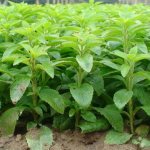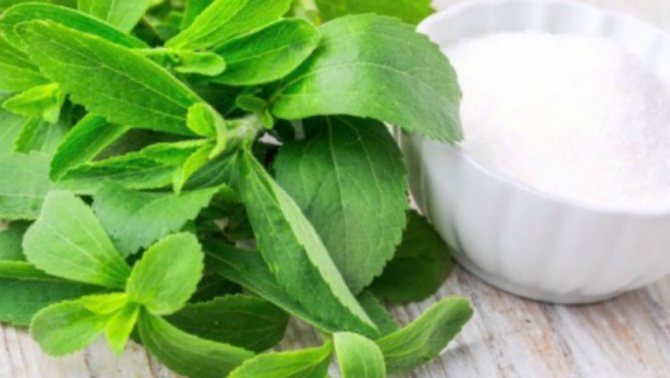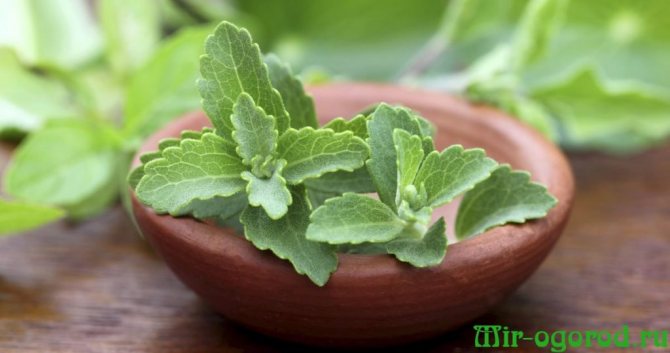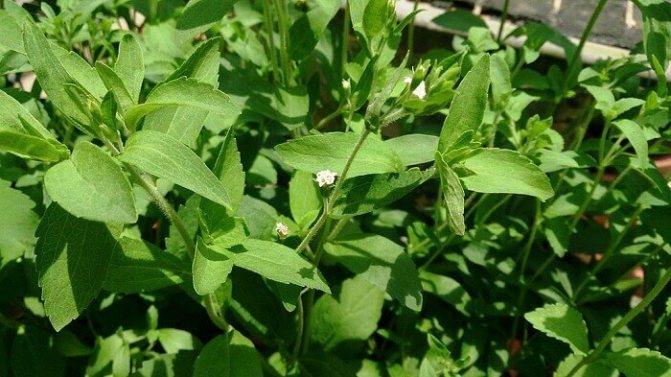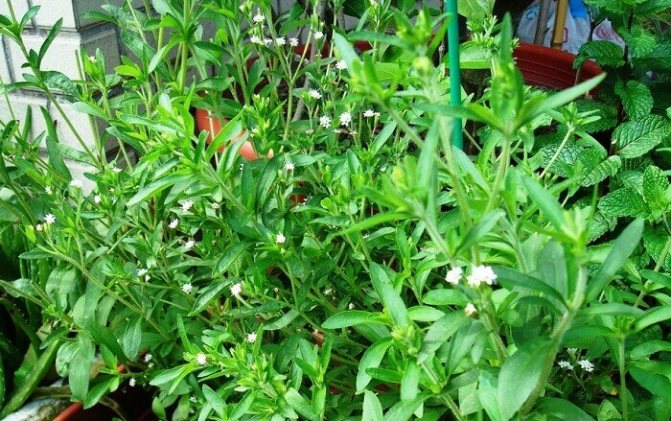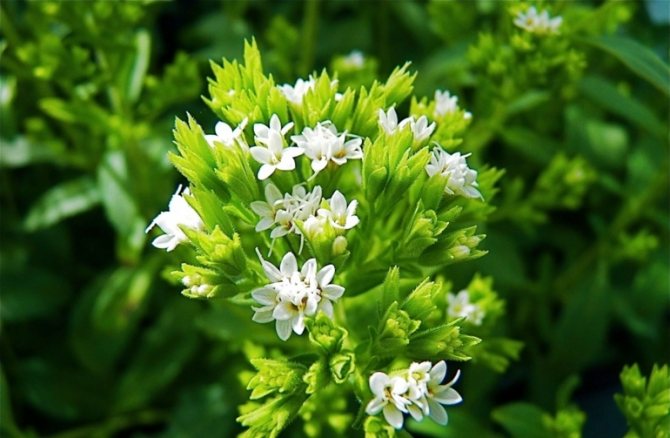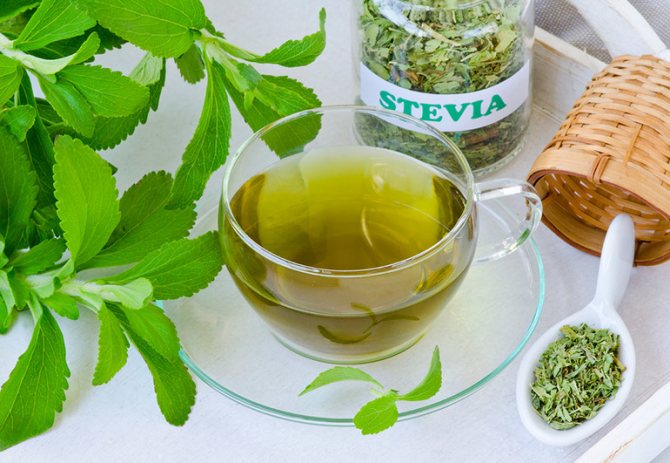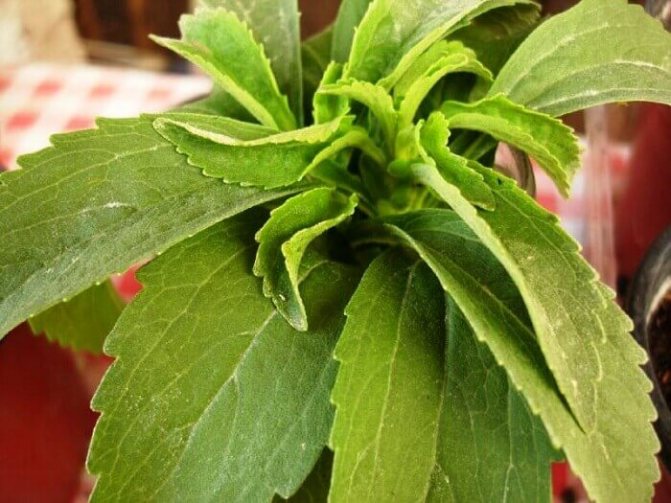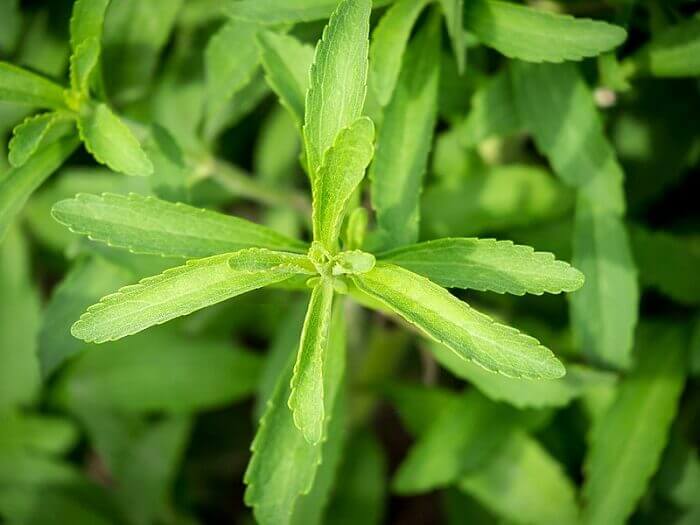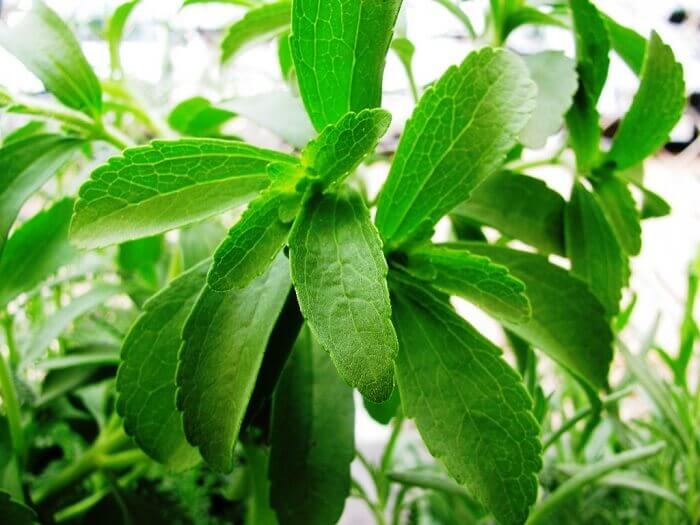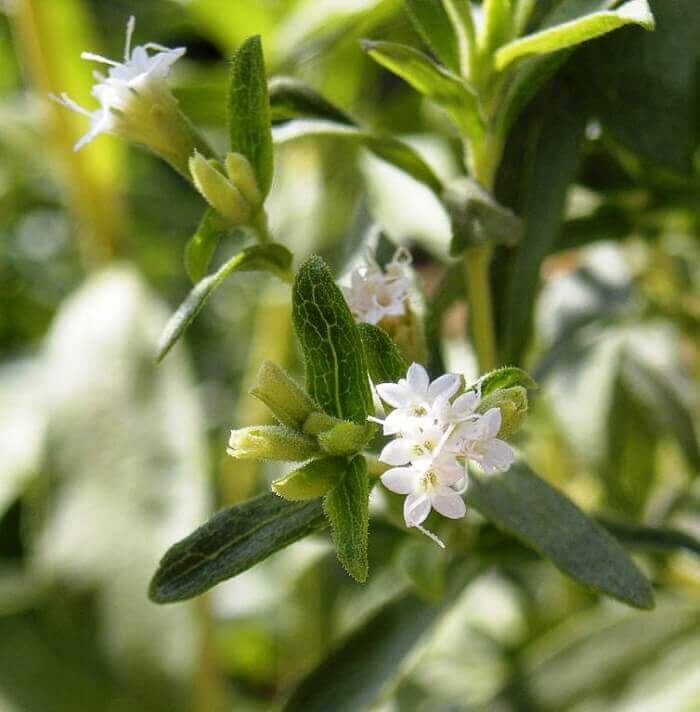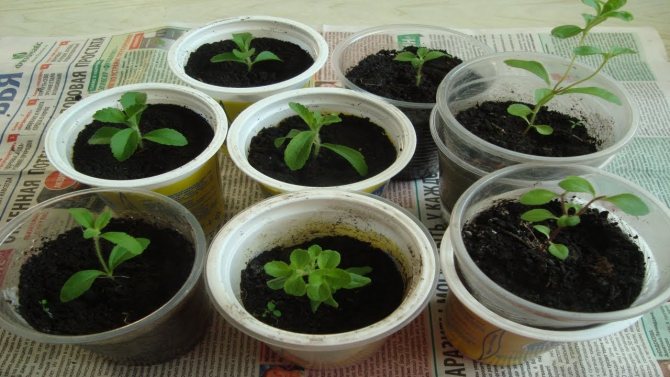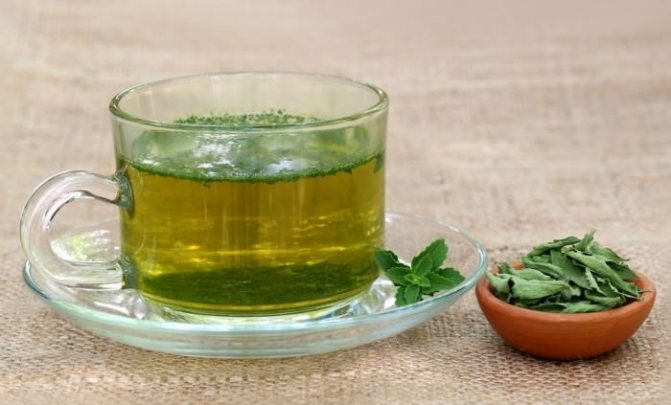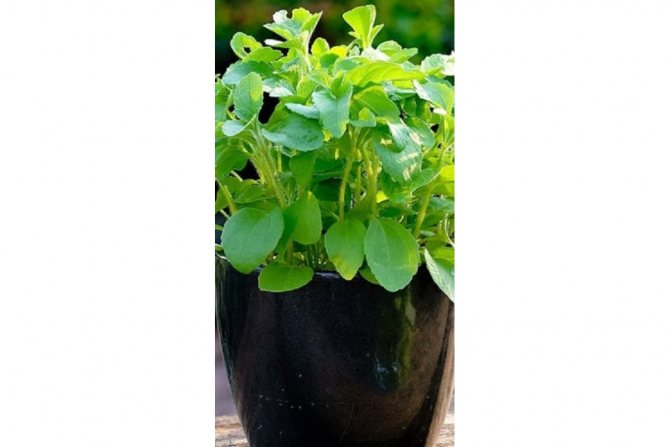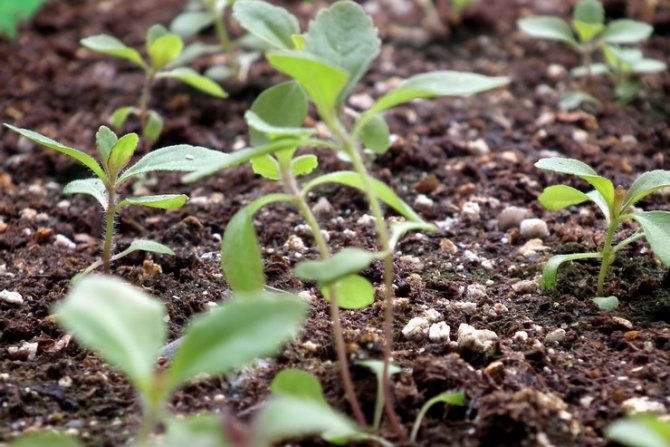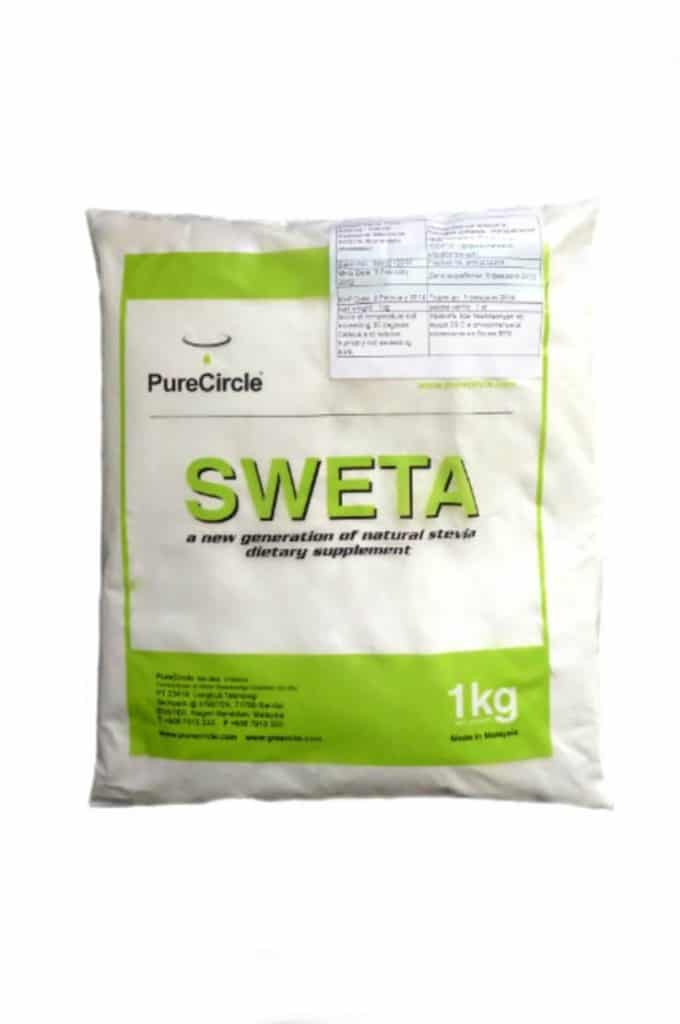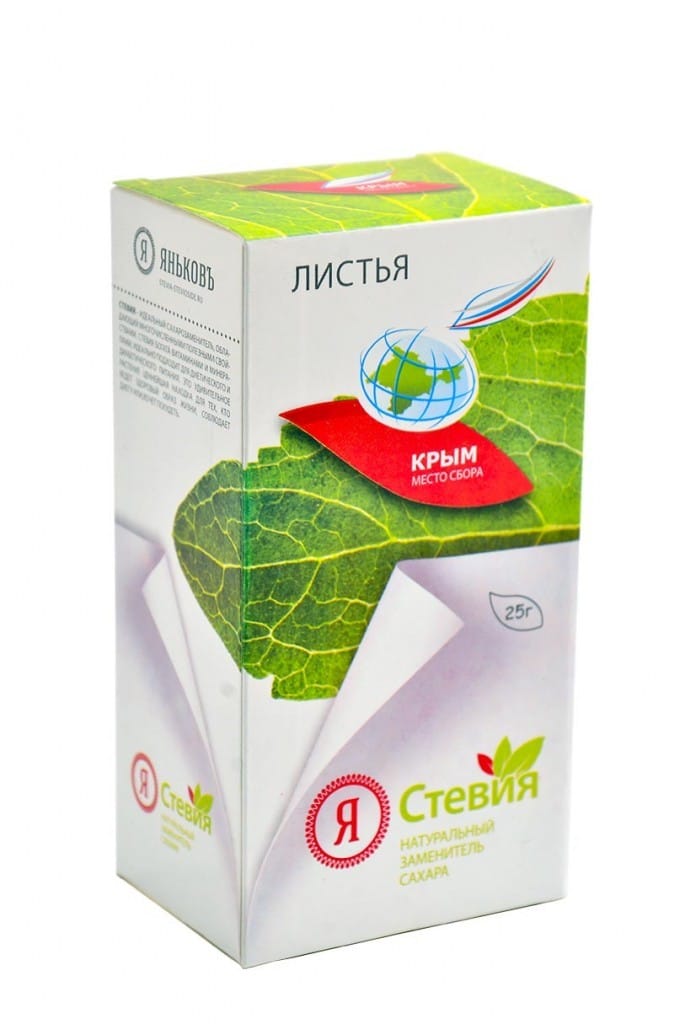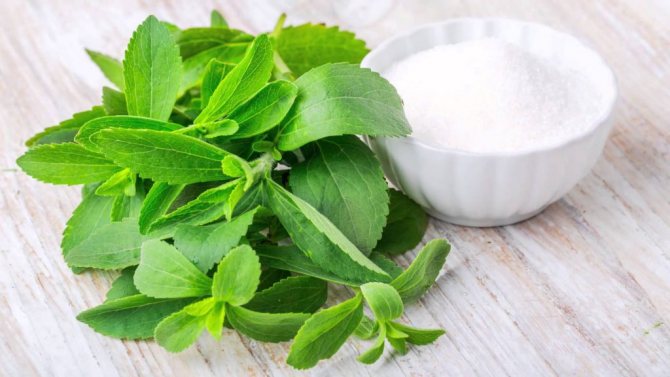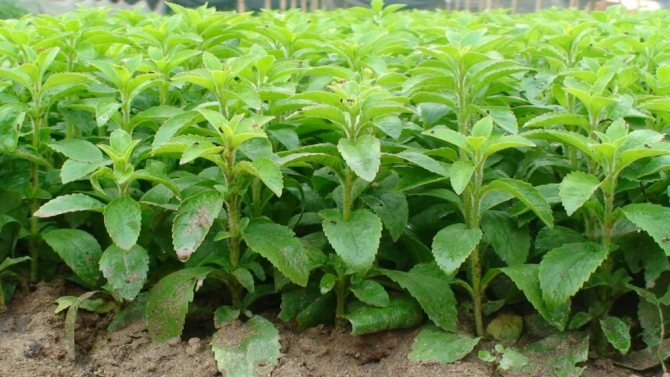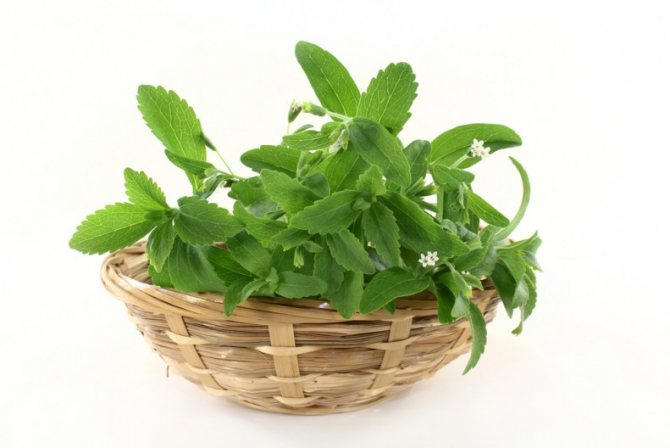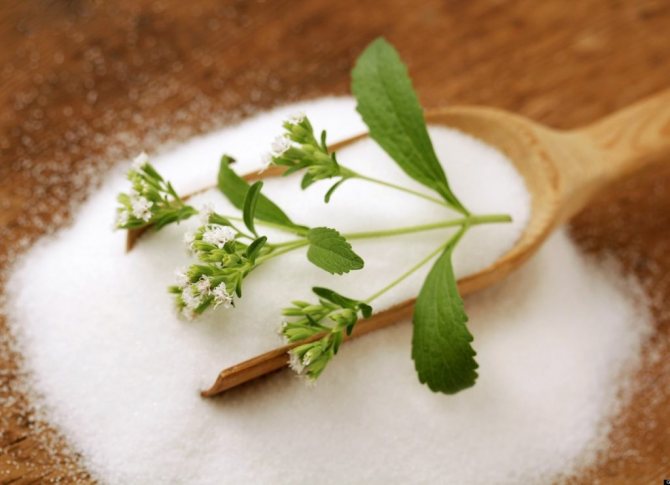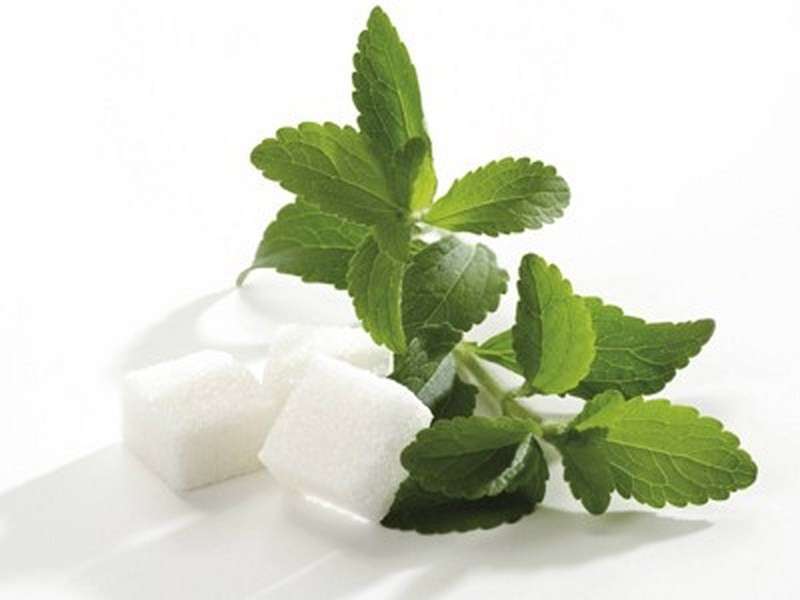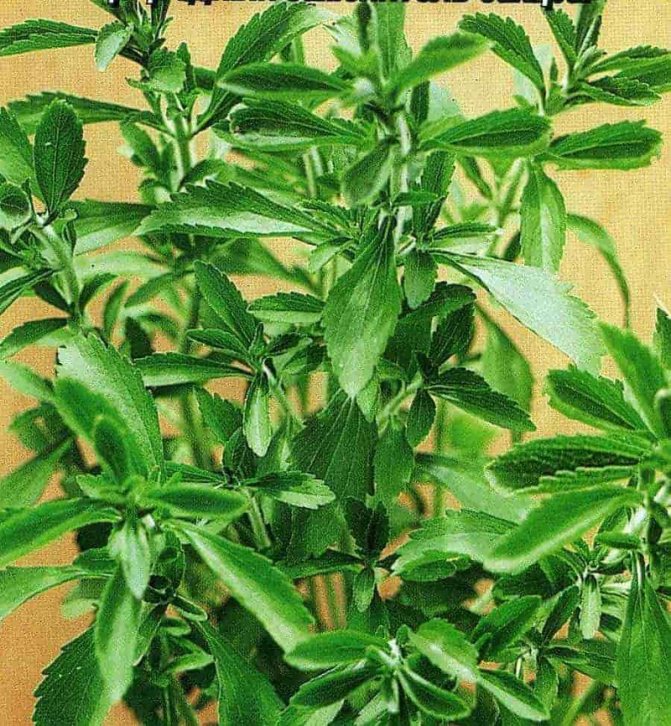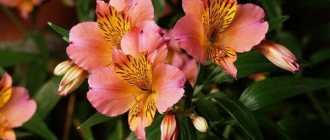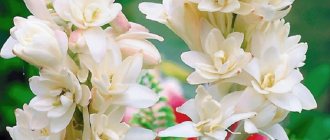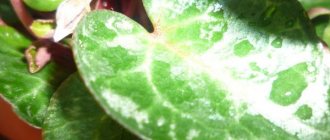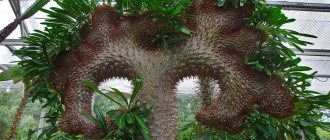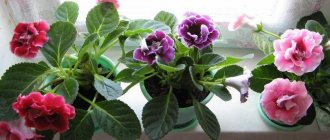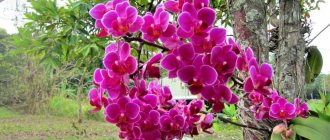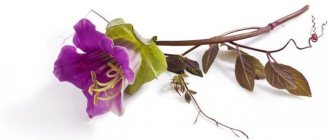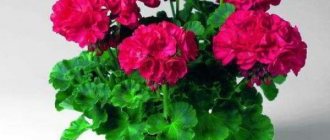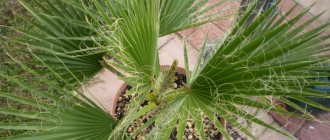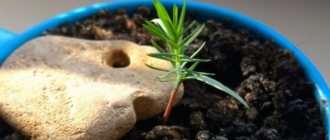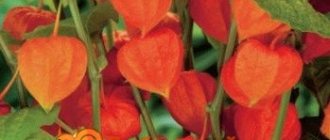Good day! The topic of sweets and sugar substitutes is one of the most popular among people with diabetes and overweight. There is a lot of conflicting information on this subject, but the undisputed leaders among sugar substitutes are natural ones. Today we will again talk about stevia, but already about growing from seeds at home, how to purchase seeds and grow it in the country and at home, planting and care, and in the end we will learn how to make syrup. I hope the material will be useful not only for avid gardeners, but also for everyone who is engaged in home floriculture. Try growing your own stevia and we'll help you!
Natural habitat of stevia
The homeland of the sweet herb is Paraguay. This country is located in South America, so the main conditions for growing stevia are heat, sun and sand.
The optimum temperature is 23-28 degrees Celsius. Protection from strong winds and drafts is required.
The soil is sand or a mixture of sand with humus with a slightly acidic medium (pH 5.5-6). The ground should be loose and very light. Worst of all, stevia tolerates peat and calcareous soils.
Since there are no cold winters in South America, stevia cannot stand the cold. Therefore, it is grown either at home in a pot on a windowsill, or as an annual plant on the ground.
Growing
In fact, stevia is not only a plant, but also an excellent remedy. It is quite possible to grow this semi-bush at home in the winter season, and in the summer in a pot on the street.
Home care is not difficult. Its height can reach 60-70 cm, and the flowers are white. Every year the stems of this plant die off, and then new ones grow. For a year, the stems can give from 600-12000 valuable leaves.
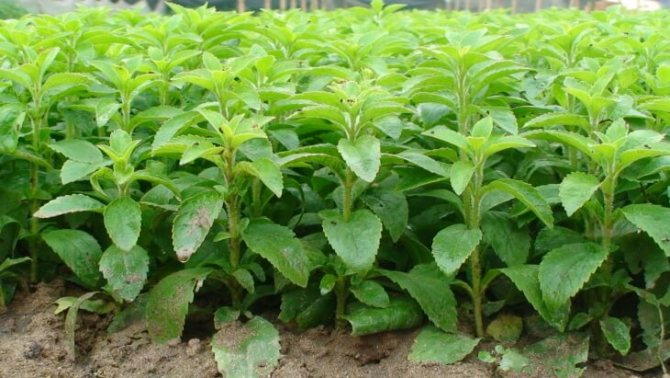
Lat. Stevia
First, we need seeds. Seeds can be purchased at any specialized store. You can also order them online or receive them by mail. Which option is convenient for you, choose yourself.
If you nevertheless decide to order via the Internet, then I recommend paying attention to how the product will be packaged and its price. For 100% germination, you need 7-10 seeds, no more.
If you do not have experience in growing this beneficial plant, it is best to purchase seedlings.
It will be much safer this way. But if you have the desire and time, then try growing stevia from seeds.
Pre-purchased seeds now need to be checked. It is easy and simple to do it, it will not take much time. Raise your hand with a seed a few centimeters from the table or surface (check each one): if it fell quickly, then the seed is good. But if during the fall it turns and turns over, then the percentage of shoots will be equal to 0.
How to properly grow stevia seedlings from seeds
Preparing seeds for planting
- Soak the selected stevia seeds for a short while in warm water and dry thoroughly, spread on cheesecloth or paper.
- After the seeds have dried, distribute them evenly over the surface of the prepared soil.
Attention! Do not press the seeds into the ground, just scatter them carefully over the soil surface.
After that, we remove the container with seeds under glass, jar or film, thereby creating a greenhouse effect.With a good combination of circumstances, the first shoots will appear in 5-7 days.
Care of young stevia seedlings
After the first millimeters of melt appear on the surface of the earth, it is necessary to start tempering them: remove the glass and remove the container or any other container in a warm, dry and windless place.
Periodically spray young shoots with water at room temperature.
In the phase of 2-3 true leaves, the seedlings can be dived into the greenhouse or left to grow in the house. In the latter option, a wide pot is required for planting seedlings (the stevia root system grows in breadth).
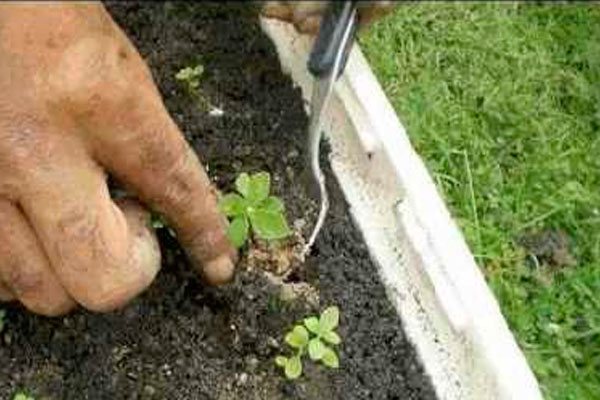

Secrets of seedling care
Stevia is a capricious plant in terms of care. While the seeds have just sprouted, and before planting in open ground, it is still far away, it is necessary to keep the plants in the right conditions.
- Keeping in a mini-greenhouse: when the stevia seedlings have spiked, they should be covered with foil or glass, maintaining constant humidity and a temperature of 22-25 degrees Celsius;
- Stevia is whimsical in watering: the plant requires not dry, but not waterlogged soil. To do this, spray the sprouts with water several times a day, constantly monitoring the state of the earth (stevia can disappear in the mud);
- We regularly "feed" the stevia: for this we spray the plant once every two weeks, alternating mineral and organic fertilizers
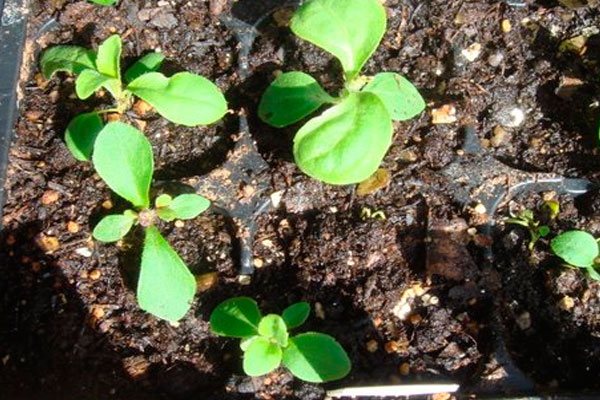

Seedlings of honey grass
When the first shoots appear under the film or can, we pay attention so that there are no weeds among them. It will be easy to distinguish them from stevia seedlings: the latter grow very slowly and are very small in size. If all the seeds have sprung up and it seems that they grow too often, we dive them through one. We transplant young plants into separate dishes with the same soil composition so that they take root well.
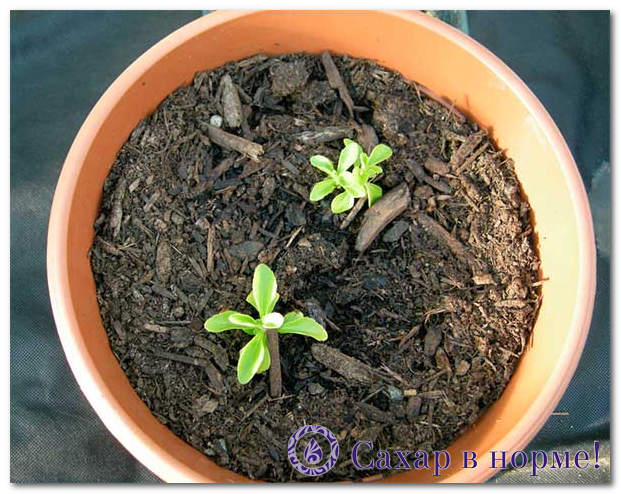

If we do not plan to grow stevia in the open field, we plant the sprouts immediately in a wide, shallow pot, since the root system of this grass, as we remember, is superficial and grows in breadth. The resulting seedlings are best dived at the age of 2 months either in a greenhouse or in pots - it is more convenient for many to monitor the microclimate of the plant. Just remember that in this case the pot must be prepared in advance and designed for an adult plant. We also cover the planted seedlings with a jar or plastic bottle to create an optimal level of heat and humidity.
When to plant seedlings in open ground
Landing in open ground is allowed no earlier than mid or even the end of June, so that the soil temperature is 10-15 ° C, no less. In addition, two weeks before the intended planting, stevia seedlings must be hardened. To do this, we open the 1.5-month-old plants and expose them to the open air, first for a couple of hours, gradually increasing the "airing" time. After the seedlings get used to being outside the shelter throughout the day, we transplant them into open ground. With such preparation, it will not be so difficult to grow stevia in the country, despite its low frost resistance.
Transplant of stevia from open ground
At the end of August and the beginning of September, the plants will need to be dug up and transplanted into a pot and taken to a greenhouse or brought into the house, since the minimum temperature at which the plant does not die is 4 ° C of heat. If there are plans to preserve live grass during the winter and return it to open ground at the beginning of summer, you should not risk it - we remove the stevia from drafts and frosts much earlier. We monitor the PH indicator: it should be neutral. If the soil is too acidic or, conversely, alkaline, we continue to keep stevia in pots even outdoors, without planting it in the ground.
Basic care
The content of stevia cannot be called troublesome, but you should not ignore the sweet herb either:
- The key to the well-being of culture is timely and competent watering.The procedure is carried out 1-2 times a week, of course, adjusted for the weather. Drought, even a short one, is very difficult for stevia, so the soil under the plants must be constantly moist.
- Sweet grass is fed every 10-15 days: under each bush poured 4-5 liters of complex or EM fertilizer, prepared according to the instructions. The culture is also responsive to the introduction of organic matter - twice a planting season is fertilized with fermented infusion of fresh mullein (1:10).
- The soil under the bushes must be periodically loosened and weeded to remove weeds that impede their growth.
1. Seven Secrets of Success:
| 1. Growing temperature: during the growing season, a room temperature in the range of 18 to 24 ° C is suitable for keeping stevia, in the winter months a cool dormant period at a temperature of 7 - 10 ° C is desirable. |
| 2. Lighting: Well-lit location with a lot of reflected sunlight. Direct sunlight can hit plant leaves in the morning and evening for 3-4 hours a day. |
| 3. Watering and humidity: Abundant and regular watering in spring and summer with light drying of the topsoil. In the fall, the frequency of watering is reduced in accordance with the temperature of the content. It is better to increase air humidity by spraying or using a tray with wet pebbles. |
| 4. Pruning: Regular pruning and pinching of the apical buds to form a lush bush. |
| 5. Priming: nutritious and loose organic-based substrate with excellent drainage and acidic pH response. |
| 6. Top dressing: in spring and summer, fertilizing 2 times a month, in autumn and winter, fertilizers are not used. |
| 7. Reproduction: by cuttings in spring and summer or by sowing seeds in spring. |
Botanical name: Stevia.
Stevia plant - family... Compositae or aster.
Origin... America.
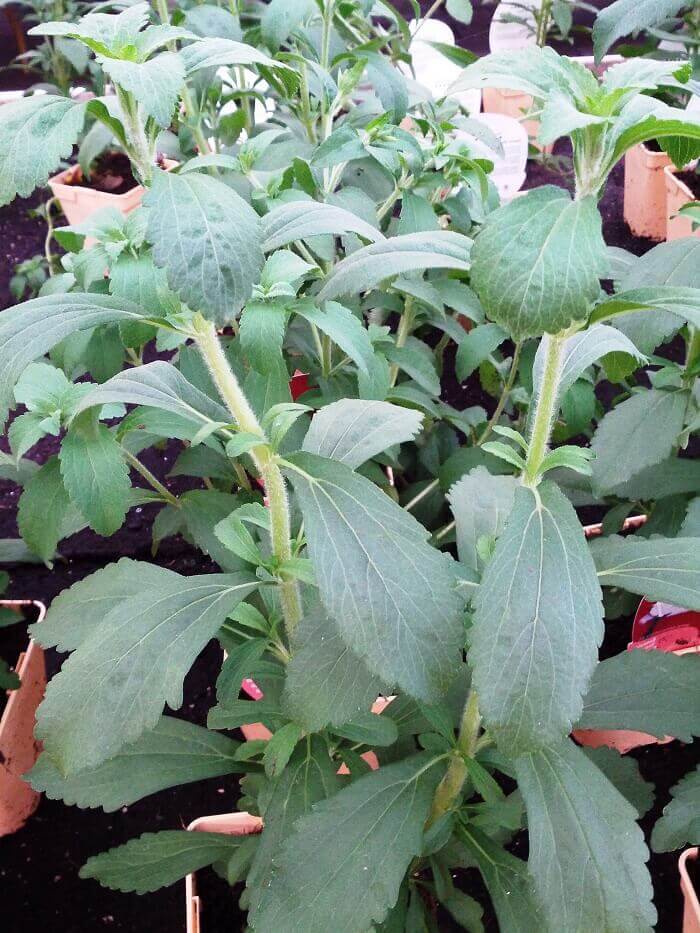

Description... What is Stevia? It is a perennial low herb with erect, branched, thin stems. Young shoots are pubescent. Leaves are green, oblong-oval, opposite. The leaf blades have small denticles along the edge and sparse pubescence. Inflorescences are apical umbrellas, bearing a mass of small white flowers. Stevia leaves have a sweet taste and are believed to be 30 times sweeter than sugar.
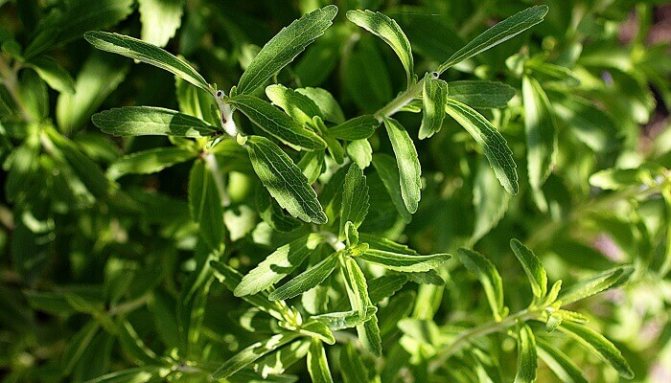

Height... About 50 cm.
Wintering features
Stevia should not overwinter outdoors - this is the main criterion to consider if you decide to plant a plant in your area.
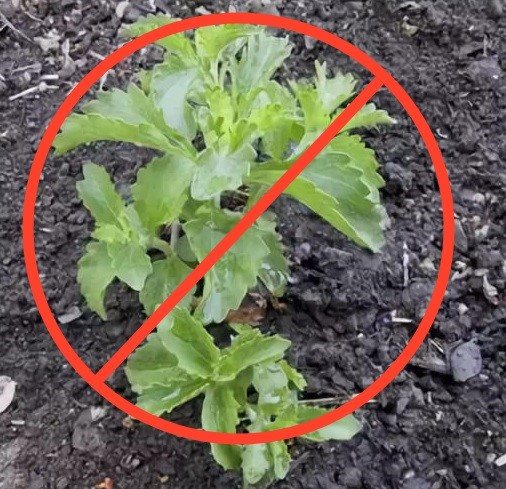

The roots left after harvesting must be dug out even before the onset of cold weather. Then they are laid in 1 layer and covered with a mixture of soil and sand so that only hemp remains on the surface. Perlite preserves the roots in the best way, so it is recommended to use it for winter storage of the plant.
The peculiarity of stevia is that it develops very slowly in the first year of life. The bushes are recommended to be kept and grown for the next year.
First shoots
It is imperative to make sure that weeds do not creep up along with the first shoots of stevia. If they appear, then they must be removed. It is very easy to distinguish them: the weeds will grow more slowly than the seedlings of our honey plant.
We transplant the grown sprouts with the same soil into a wide pot. A deep pot is not needed, because the roots of this shrub grow in breadth.
The resulting seedlings should be replanted after 2 months. Always when transplanting, you need to prepare a pot for the future plant in advance, and count on its size.
After transplanting into new pots, they should again be covered with a foil, or with a large bag, and if there is absolutely nothing at hand, you can cut out the shelter from a plastic bottle.
How to plant stevia outdoors
The best time to transplant stevia into open ground is late March - early April (the plant grows ideally with an 8 hour daylight).
When Stevia reaches 20 cm in height, the plant can be planted outdoors in the country. Before planting, you need to carry out the formation of seedlings. To do this, you need a few secrets.
How to prune stevia
We cut (form) the plant:
- It is better to choose a warm time for pruning: the end of May-beginning of June will be the most suitable.
- We cut off only the tops of the plants.
- Pruning is carried out when the seedlings have lived in the open air for several months, so we will allow new, lateral leaves to appear, which can later be used for rooting.
How to Purchase Stevia Seeds
Since we will grow stevia directly from seeds, it is worth finding out in advance where to get them. This plant belongs to the family of Asteraceae or Asteraceae, and, despite the prevailing opinion that only a small percentage of seeds germinate, stevia is cultivated very successfully in northern countries, but more often as an annual plant.
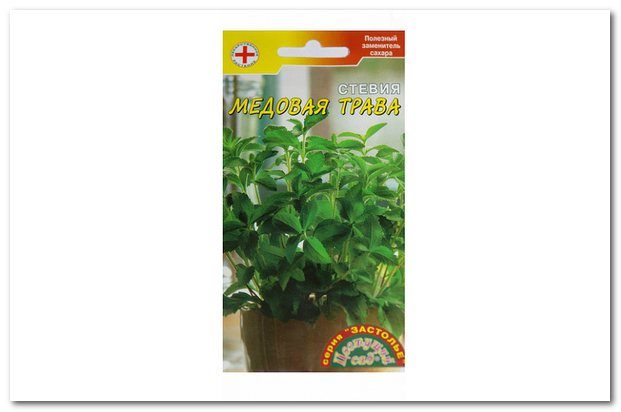

Small stevia seeds - only 0.5 mm wide and 4 mm long - are easy to purchase online and receive by mail. On specialized sites, you can find different packaging and, accordingly, you can find a wide range of prices for this plant. The minimum number of seeds in one package is 7-10 pieces with a guarantee of a high percentage of germination. Today, the questions of where and how to buy stevia seeds are no longer there - we order an exotic plant and receive it by mail!
Stevia herb: plant hardiness
But to grow stevia outdoors, there are a few important things to keep in mind. The frost resistance of this herb is considered low and not suitable for our latitudes, which is why growing it in the country is fraught with certain difficulties.
Preparing to grow stevia from seed
There are two main steps that, if done correctly, will ensure a good chance of grass germination.
- Soil preparation. To create a soil similar to the natural stevia soil, you need to mix sand, black soil and humus. You can buy them in garden centers, or you can get them yourself in the forest. To get humus, peel off the top layer of foliage. The soft layer to the hard soil layer is the humus. It is better to buy black soil and sand in the store. You need to mix the components - 2 parts of sand, one part of humus and 1% of black soil. By the way, on the Internet I saw ready-made soil mixtures specifically for growing honey grass.
- Stevia seeds. Seeds can be bought, and with long-term cultivation of grass, you can harvest it yourself as a crop and a nice bonus. When collecting, pay attention to the windage of the seeds. Raise the seed half a meter above the ground and drop it. If it falls quickly, the seed is suitable for growing. Slowly flying grain is a barren flower. They are unsuitable for further use.
Application of stevia leaves
As a rule, stevia leaves can become the basis for the preparation of various extracts, decoctions, infusions, and hot drinks. In this case, it is not at all necessary to use stevia mono-herbal tea. Often, "honey herb" is used in preparations and mixtures together with other medicinal plants. Cooking dried leaves is quite simple: just grind them in a coffee grinder or in a mortar. It is worth remembering that one tablespoon of the resulting powder will replace 100 grams of regular sugar.
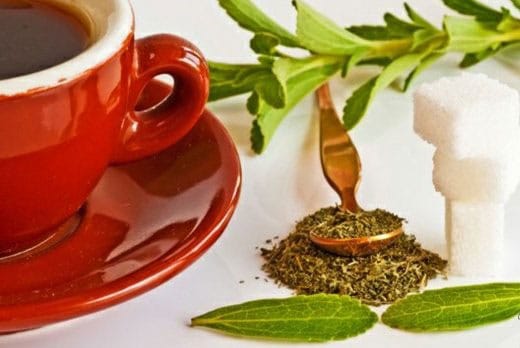

Growing stevia
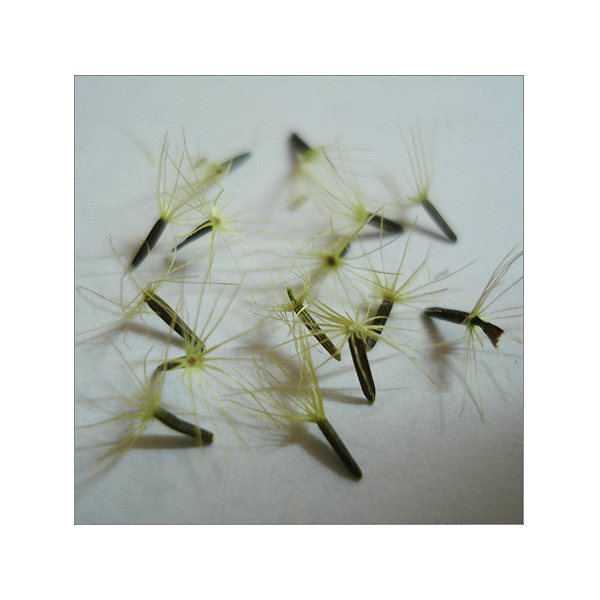

Stevia seeds
Growing stevia from seeds is not an easy task. This is a very moody plant. Most seeds end up unsuitable for growing. The seedling period for stevia lasts about 2 months, so they start sowing seeds in April.
- Prepare boxes and soil for seeding.
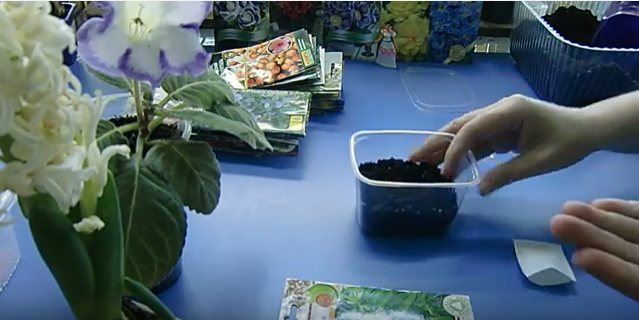

Preparing the soil and container for planting
- Make small dimples on the surface of the ground and place 2-3 seeds in each.
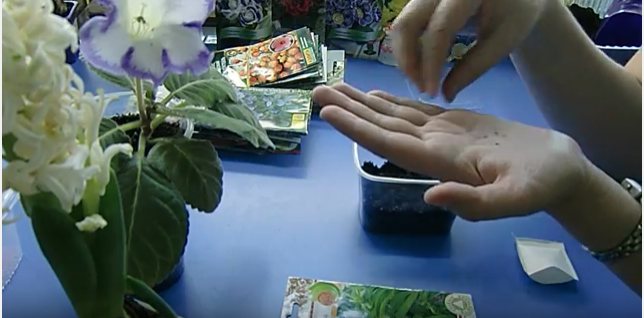

Planting seeds
- Lightly sprinkle the seed dimples with soil - the layer should be no more than 3 cm.


Sprinkle with earth
- Moisten the soil surface with water using a spray bottle and cover with foil or glass.
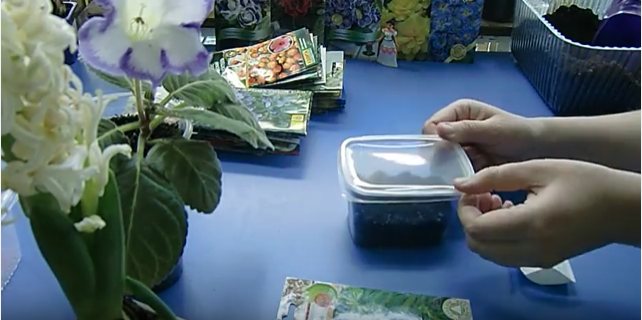

How to create a greenhouse effect
- Put the box with future seedlings under a UV lamp. The first days do not turn it off, even at night.
- Provide an air temperature of at least 25 degrees in the room with boxes.
- The first shoots will appear in 1-2 weeks. After that, immediately remove the cover from the seedlings.
- After 3 weeks, reduce the operating time of the UV lamp to 15 hours per day.
- When the seedlings have strong leaves, it is thinned out, removing frail plants.
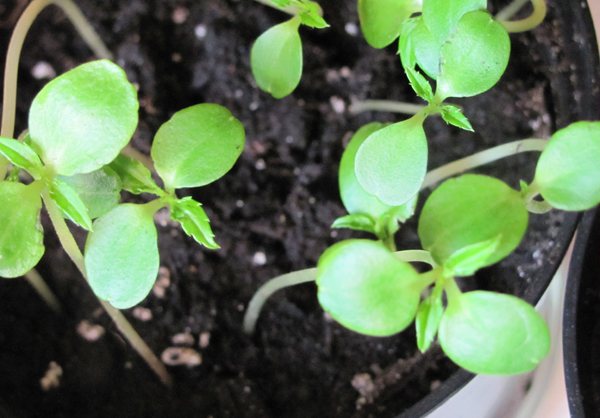

The first sprouts of stevia
Stevia can also be grown from cuttings. This method is much simpler than the previous one, but it will require a mother plant of at least 2 months. Cut off the cuttings-tops of the shoots with a length of about 10 cm should be in May-June. Before rooting, the lower leaves are removed from it, then they are dug into the ground to a depth of 6 cm, sprayed with water and covered with a jar or film. At first, the cutting and the soil around it are sprayed several times a day with a spray bottle. Rooting takes place within 10 days.
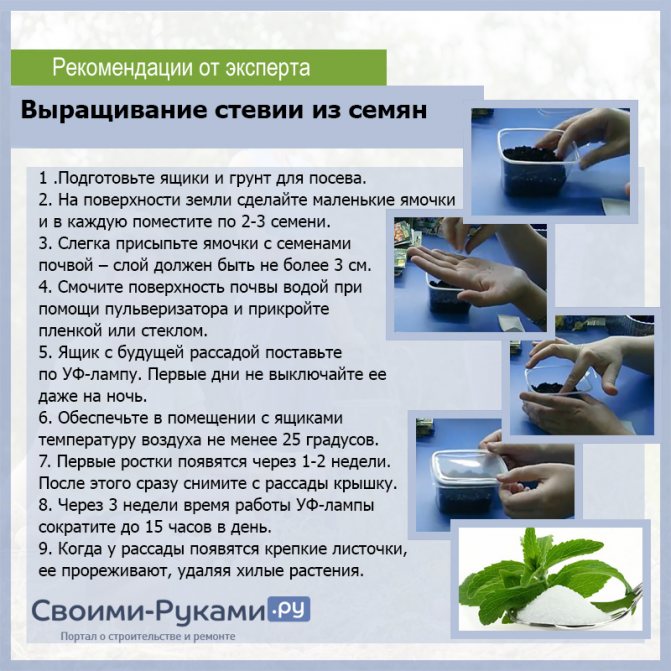

Growing stevia from seeds
Video - Growing stevia seedlings
Stevia use, recipes
Powder made from stevia leaves is used as an additive in all dishes to which sugar is added. Drinks, cereals, pastries - this is not a complete list.
If you like sweet pastries, but are afraid of high calorie content, feel free to add powder from dried stevia leaves. The calculation is simple: two to three teaspoons of powder will replace a cup of granulated sugar.
If you like to start your morning with a smoothie, add one freshly plucked honey leaf. The sweet taste is provided, but the calories are not added to the ingredients.
The ideal use of the stevia leaf is in tea, because it not only adds sweetness, but also makes the drink most useful.
In order not to miss any material you are interested in, subscribe to the newsletter of our site! It's easy to do, and you will get huge benefits from the subscription.
Stevia compote
Stevia is added to fruit and berry compotes instead of sugar as a sweetener. Depending on the preferred sweetness, add 60 to 120 grams of dry leaves per liter of compote after being removed from the heat.
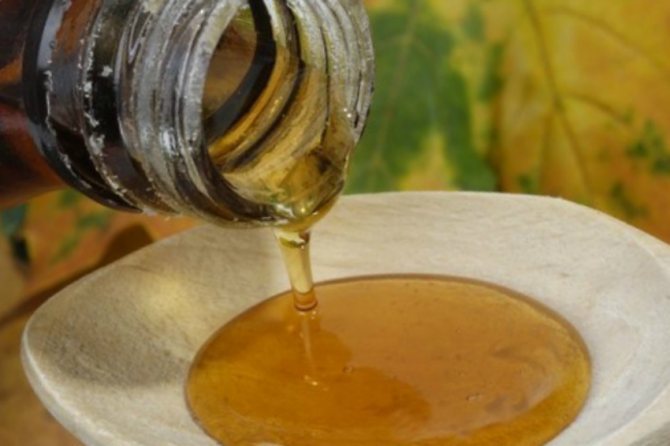

Stevia syrup
Place two teaspoons of dried stevia leaves in a small cloth bag. Dip in a small saucepan, pour 250 ml of boiling water. Put on low heat and cook until a consistency resembling honey. This syrup can be used to sweeten drinks such as tea and jelly. No more than 1/3 teaspoon of syrup is enough for a glass of tea.
Growing stevia from seeds is a rather troublesome task, but by sowing a plant once, you can get sweet leaves for several seasons.
Harvesting
Harvesting sweet grass begins at the beginning of flowering, which occurs 16-18 weeks after sowing, that is, in July. Harvesting can be done until mid-September. Plants are cut at a height of 5-10 cm from the soil surface, tied in small bunches and hung to dry under a canopy or in a well-ventilated utility room. Some gardeners prefer to dry the stevia in bulk: the leaves are torn off and laid out in a single layer on paper.
In late August - early September, sweet grass seeds ripen, which will be useful to you in the next season. The signal for the collection of seed is the blackened peduncle of the plant. The main thing is not to miss the moment, otherwise the ripe seeds will scatter.
Fresh stevia is added to tea to add sweetness or used to decorate desserts. Powdered dried leaves are not only a natural, but also a very economical sugar substitute. Only 2 tablespoons of powdered raw materials can replace a whole glass of "white death". In addition, alcoholic tinctures and syrups are prepared from stevia for the winter, which are used in cooking as sweeteners.
What is Stevia
Stevia is a whole genus of perennials from the Astrov family, which unites more than 250 species of all kinds of shrubs and herbs. Their homeland is the plains and mountainous regions of America. The most popular type of stevia is honey, which is cultivated in summer cottages. This plant was first studied by the botanist Stevus in the 16th century, after which it was named. The fact that stevia honey is used as food by the aborigines was established at one time by the scientist Antonio Bertoni during his expedition to Paraguay. He noticed that the Indians called this plant "Guarani" and prepared delicious and sweet drinks from it.
Fresh articles about garden and vegetable garden
Winter garlic turns yellow: what to do?
Yeast as a plant fertilizer: how to prepare it?
Soaking seeds in vodka: benefit or harm?
The fact is that stevia is a natural substitute for sugar: a couple of leaves of the herb are enough to sweeten a cup of tea. Its leaves contain a substance that in the twentieth century was called "stevioside" - it is hundreds of times sweeter than ordinary sugar. By the way, stevioside is recognized as the sweetest natural product in the whole world. Honey stevia is a semi-shrub up to 80 cm high, abundantly branching, with small paired leaves and a developed root system. It blooms with small white flowers. It is now widely used in food preparation in Asian countries and South America.
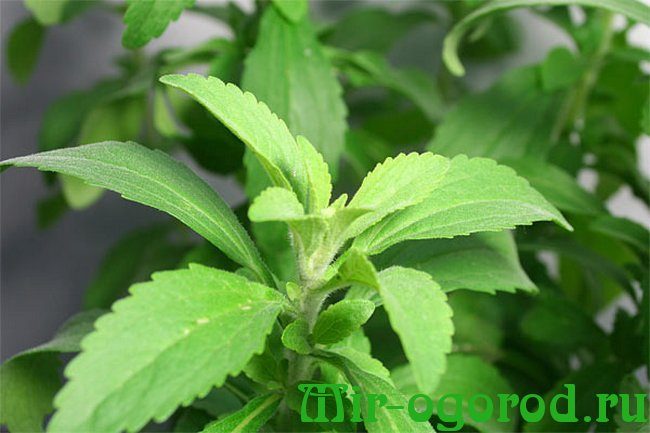

Open ground transplant
Moving stevia to the street is one of the most crucial moments. Wrong actions can ruin all your work. Before the plants finally move to the street, it is important to harden them. To do this, the seedlings are first dived into separate pots and then put them outside for several hours every day. The weather at this time should be warm and sunny. Each time, young stevia stays on the street longer and longer.
Planting stevia in the ground is done when the risk of frost is minimal.
Landing in the ground is carried out when the risk of frost is minimal, and the air temperature during the day is kept at least 18 degrees. The procedure is best done in the evening.
- We dig the site for stevia well, remove the weeds.
Digging up a site for stevia - We dig holes up to 8 cm deep at a distance of at least 40 cm from each other.
- We apply organic fertilizers to the pits (about 0.5 kg of humus).
- We take out the seedling from the pot along with a lump of earth and lower it into the hole, sprinkle it with soil and tamp it.
Planting stevia outdoors - Water or spray the soil a little from a spray bottle.
Transplanting stevia into open ground
For the first time, until the plants take root, they are covered with a film. Since the roots of stevia are located close to the surface, the soil around the plant is mulched so that they do not dry out.
Video - How to properly plant stevia in the ground
Stevia varieties
Despite the benefits and sweetness of stevia, gardeners are not yet actively interested in this herb. At the same time, several varieties of it can already be distinguished. Most popular:
- Detskoselskaya. A plant of this species has a height of 50-60 cm. The bush reaches 30 cm in diameter. Such a stevia can be recognized by its characteristic pubescence on the stem and its light green color. The leaf resembles an ellipse in shape, reaching 4 cm in length. During the flowering period, light beige buds appear on the bushes.
- Dulcinea. The stem of this plant is higher: up to 110 cm. It is round. This species has specific leaves with a crenate edge. They, like the stem, are covered with hairs. The Dulcinea flower is white in color, reaching 4 cm in diameter.
Less popular, but also famous stevia varieties: Uslada, Sofia, Ramonskaya sweet tooth. When processing raw materials, we use advanced technologies and precise formulations to eliminate bitterness and preserve the beneficial properties of the herb.
How to prepare stevia herb at home
It is necessary to harvest honey stevia at the beginning and at the end of summer.
For this:
- Cut off the stem of honey stevia 15 cm from the ground;
- We break off the leaves;
- We dry them in any convenient way: in the oven or in the sun (usually it takes 6-9 hours to dry);
- Grind (optional) and remove before use.


Contraindications and harm of sweet herbs
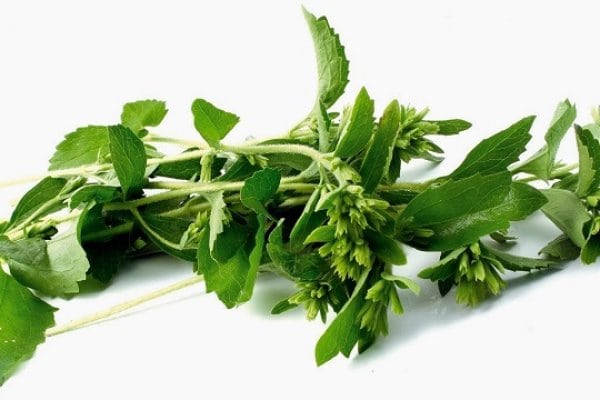

In case of an overdose, the sweet herb can harm the body. Various studies have been carried out on the effect of stevia on the human body, unfortunately, no consensus has been found about it. For example, the US Food and Drug Administration does not recognize the plant and foods that contain stevioside.
The healing property is opposed by the likelihood of a violation of the reproductive system, which leads to infertility. There is a legend that in the early days, tea drink with powder was taken as a medicine that prevents pregnancy.
How to grow stevia from seed at home
- The right time for seedlings is March - April. Even if you grow herbs at home, it is important to respect the seasons. If additional lighting is used, you can plant the stevia a month earlier.
- The growing container can be any. Beginners are advised not to start large boxes, but to limit themselves to a plastic cup.
- The thickness of the soil should be 10 cm.
- Pre-soak the seeds in warm water for 30 minutes. Then dry it a little.
- How to plant stevia seeds - make many small depressions in the soil, 5 millimeters each, and put 1-2 grains there. Cover with soil. Spray a little water on top from a spray bottle.
- The stevia plant is very fond of warmth and light. Therefore, cover the seedlings with a plastic or glass lid, and place in a very bright place. Ideally, it should be placed under a fluorescent lamp. But you can not put in direct sunlight.
- When the seedlings sprout, they need to thin out and remove the lid.
- Monitor soil moisture. It should be slightly damp. If you can, do bottom watering.
- When the grass reaches 5 cm, transplant it into seedling soil. It differs in the following - instead of one part of sand, you need to add one part of sod land. Plant the shoots at the depth of the first leaves.
- Once a week, you need to feed the stevia with mineral fertilizer.
- When the grass reaches 10-12 centimeters, cut off the top a little. Then it will start branching.
- The seedling period of stevia is 8 weeks.
- After that, you can plant it in a permanent habitat - in a flower pot. Don't forget to make the bottom drainage layer out of pebbles. Enough 3 centimeters. Next is the seedling soil.
What is this plant?
A bush with straight stems, on which a large number of bright green leaves are located - this is what a stevia plant looks like in nature. To date, more than a hundred varieties of this shrub are known, however, in folk medicine, the species Stevia rebaudiana is of greatest interest. Stems of perennial grass die off every year, and new ones are formed in their place. Up to 1000 leaves can be harvested from one shrub, which are the real sources of vitamins and minerals.
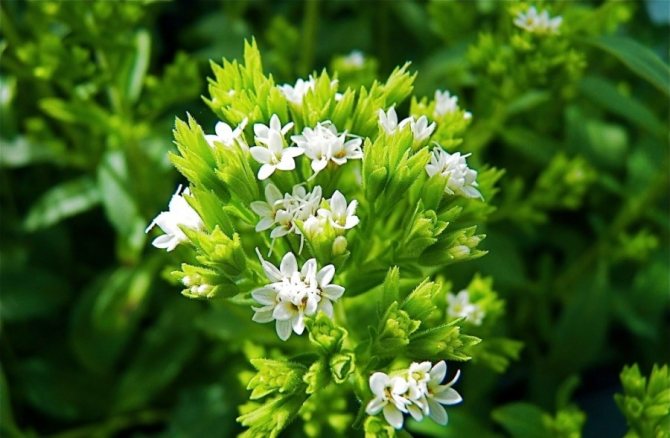

Stevia herb was first discovered in South American countries. As soon as the healing properties of the plant were discovered, they began to cultivate it in Asia, and then it migrated to our latitudes. The warm climate of the mountains, moist soil, high air humidity are the best conditions for this plant.
Stevia is a honey herb, as it is often called by connoisseurs of the sweet taste of the leaves of the plant. The sweetness of this natural product is thirty times greater than regular sugar, so stevia leaves are used as a natural sweetener.
A large number of vitamins of groups E, B, D, C, P, which are of great value for the human body, useful trace elements, essential oils and tannins are found in the composition of the plant.
In the complex, all the elements have a beneficial effect on the human body, fight some diseases.
Benefits of Stevia:
- Low calorie content.
- The presence of antiseptic qualities, the ability to fight pathogenic microorganisms and fungi.
- Preservation of natural qualities even at high temperatures, which is important when cooking.
- Safety for humans.
- It dissolves well in water.
Planting seedlings to a permanent place
A native of warm countries, stevia will grow best in a sunny area, sheltered from the wind. The soil is preferable loose, slightly acidic, generously filled with humus or compost, but the content of peat or lime in the composition is unacceptable. Shortly before planting, the site is dug up, weed roots are selected from the ground and the soil surface is carefully leveled with a garden rake.
Seedlings are planted in the evening or in damp, cloudy weather. The bushes are transferred with a lump of earth into shallow (6–8 cm) holes, covered with earth and watered with warm, settled water. At the end of the procedure, it is recommended to spud the plant stems with dry soil by about a third. To make the adaptation of seedlings painless, for the first 2-3 weeks, the garden bed is covered with a film or non-woven material.
Table of contents
- What is this plant?
- What is the use of the plant
- Contraindications for use
- Stevia use
- Application of stevia leaves
- Slimming stevia
- Stevia is a natural sweetener
- How to use stevia instead of sugar?
- Stevia recipes
- What do we offer?
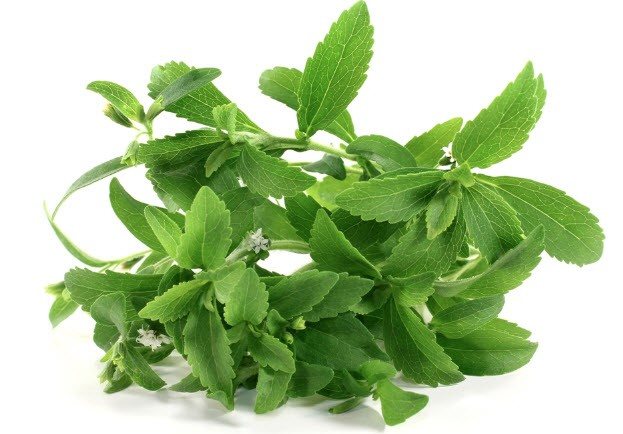

The centuries-old history of the use of this natural substance indicates positive results. But, it is still recommended to use stevia for medicinal purposes after talking with a qualified doctor.
How to make stevia (extract, syrup)
There are not so many ways to prepare decoctions and syrups from honey stevia - this plant appeared in our country relatively recently. Here are some of the most popular stevia recipes.
Tea
Most often, sweet herb is consumed with tea.
- To do this, add the crushed leaves of the plant to the tea leaves in a 1: 1 ratio, if desired, you can add a little mint or cinnamon.
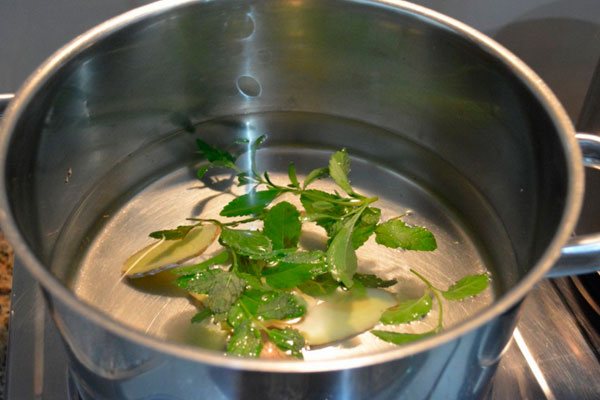

Stevia extract with vodka
- To prepare the extract, it is necessary to mix whole or crushed stevia leaves with vodka in a ratio of 1:10.
- Let it brew for 24 hours and strain through a sieve.
- Add water to the finished extract to taste.
Harvesting stevia honey
Stevia is known to be an excellent natural sugar substitute that does not cause an increase in blood glucose levels. As a result, it can be used by both types of diabetics.
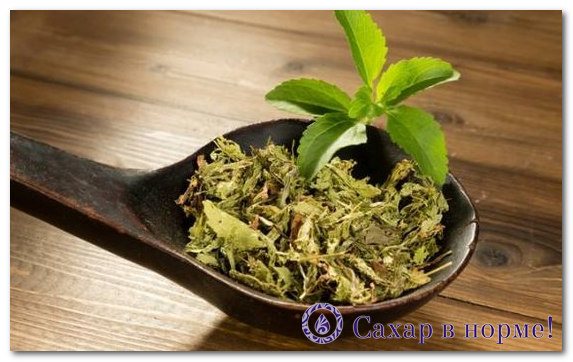

In addition, honey grass is several hundred times sweeter than regular sugar, so not much is needed to sweeten drinks and food. There are several ways to harvest stevia.
Drying stevia
Drying and chopping leaves is one of the easiest harvesting methods.
- When the time comes to harvest, we cut off the stems with a pruner and remove the leaves from them.
- We dry them in any convenient way - in the sun, in the oven with low heat, or in a drying cabinet.
The main thing is not to overexpose them at high temperatures for more than 12 hours, so that the sweetness does not disappear. Grind the dried leaves in a regular coffee grinder or blender bowl, pour into a jar and store for at least a few years. How to use dried stevia
- If necessary, add them to the drink, brew them and use them as herbal tea.
- And for baking or other stevia-based dessert, pour 80-100 g of chopped leaf into a linen bag and brew 1 liter of boiling water. In 10-12 hours we will have a sweet broth.
- If you need to add stevia to porridge, batter or dairy products, you don't even have to brew it, but simply grind it to a fine powder. We put it right like this.
But besides simple drying of the leaves, stevia can be prepared for the winter in several more ways - by boiling syrup or extract.
Stevia extract recipes
You can make an extract from stevia leaves at home with both alcohol and water. The difference will be in the sweetness - in the first case, it will be even more noticeable.
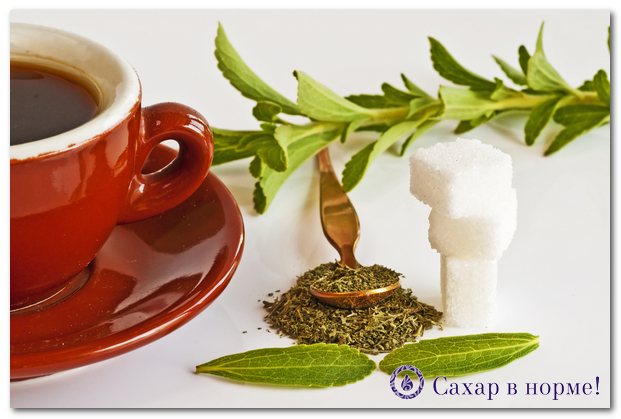

We stock up on dry leaves and vodka or other strong alcohol, such as whiskey or brandy.
- Fill the dried stevia leaves with alcohol in a ratio of 1:10 and leave for 24 hours.
- Then we filter it and we can use it directly, diluting it with clean water, or we can heat the resulting liquid, but not bring it to a boil, this will help reduce the alcohol content.
We make an aqueous extract in a similar way.
- Fill the leaves with water in a ratio of 1: 5 and begin to evaporate over very low heat.
- We hold this for 15 minutes, then filter and resume heating until the volume of liquid decreases 5 times.
How to grow stevia in the open field in the country
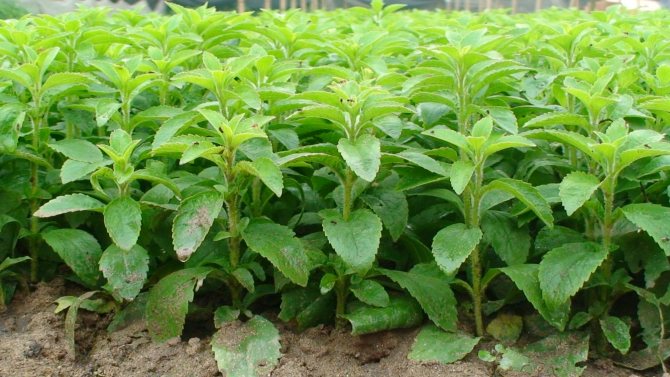

Prepare the seedlings as described above.
- It is necessary to plant stevia on the ground at an average daily temperature of 15-20 degrees. This is usually May or June.
- Dig up the soil and remove all weeds. Sweet grass is very difficult to tolerate being close to other plants.
- You need to plant seedlings to a depth of 6 centimeters. The distance between plants is about 30 centimeters. Add 300 grams of humus to each hole. After planting, pour a liter of warm water, and sprinkle with dry soil no higher than a third of the plant's height.
- Cover the grass planting site with agrofibre for 2 weeks.
When growing honey grass on the ground, it is important to remember about its cold intolerance. Therefore, for the winter, the roots will need to be dug up and stored until the next planting. This method of growing stevia is more effective than every year and from seeds, since every year the roots will grow stronger and give more and more yield.
Roots survive overwintering in a box with the ground, at a temperature of 4 to 8 degrees, and at a humidity of about 80. Usually, such conditions are in a cellar or basement.
Some helpful tips for grooming and growing
Try to water the stevia with boiled water, not raw water. If this is the winter period, you need to additionally highlight the plant, so its leaves will be as sweet as in summer. Also, the leaves must be torn off periodically (every 4 months). They can be dried and refrigerated.
While watching the video, you will learn about growing stevia.
I am more than sure that you already wanted to grow this plant yourself. Don't be afraid to grow stevia in your country house or windowsill. Subject to all the rules, the plant will develop well and feel great in your home.
Attention super FLY!
Medicinal plants
Interesting to read:
- Stevia is a healthy honey herb. Growing and care
- Special conditions for growing pepper nightshade
- The main features of growing gerbera from seeds and plant care
- How to plant a violet: basic tips and tricks for planting and care
- Dieffenbachia: transplantation and plant care
- Torenia Kauay: description and landing rules
- The main features of growing lemon balm and plant care
- Perennial primrose: the main characteristics of growing from seeds
- Growing petunias from seeds: care features
How to root stevia cuttings
Do not rush to throw away unnecessary cuttings after pruning young plants - in the future, they will facilitate the process of stevia propagation.
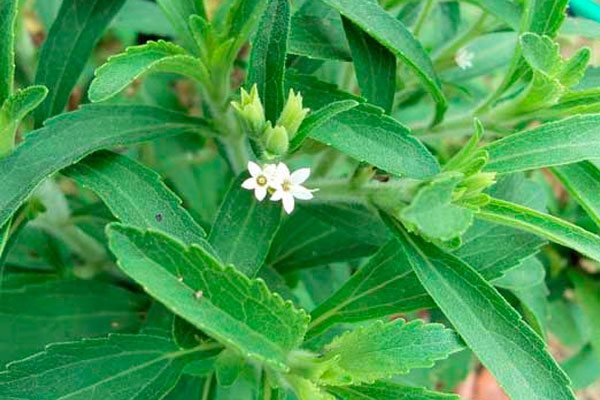

To root stevia cuttings, you must:
- We put the cuttings in a jar with slightly sweetened water;
- Cover the jar with an opaque, preferably black cloth;
- We put the cardboard stand on the jar so that the leaves do not sink into the water;
- We change the water every 3 days, and spray the cuttings with fertilizer;
- After two weeks, we transplant the cuttings into the soil.
After planting the cuttings, cover them with foil for at least a week. We take care of stevia cuttings in the same way as for seedlings obtained from seeds: we regularly spray with fertilizer and try not to overmoisten or dry out the soil (Stevia may simply die).
These were the general rules for growing any kind of stevia. As for honey grass, this type is distinguished by the ability to prepare it.
Remaining cuttings
Thickets of stevia
We are not in a hurry to throw them away. Reproduction of stevia by cuttings is much faster, and most importantly more reliable than seeds.
In order for our cutting to take root, you need:
- Pour water into a jar, add a little sugar there, stir and put the cuttings. The calculation of sweet water is done as follows: put 1 tsp for 1 liter of water. Sahara.
- You need to cover the container, it will be better to have a dark bag so that it does not let light through.
- In order for the leaves of the cutting not to fall into the water, you need to fix it.
- Necessarily, every 3 days you need to prepare a fresh solution, and do not forget to spray the leaves periodically.
After completing all the points, they can be safely planted in a couple of weeks. Planting rules are exactly the same as with seeds.
How to grow stevia at home
Stevia seedlings are very popular with gardeners; this planting method is considered more reliable. However, growing this plant with seeds is also quite realistic, you just need to know some of its features.
Stevia seed selection
After purchasing seeds, first of all, it is worth checking for empty seeds in the package. The fact is that in a temperate climate, 70% of the seeds are empty and completely unsuitable for growing.
It is quite simple to check if the seed is full: throw each one at a distance of 50-60 cm from the floor and watch how they fall - full seeds will fall faster, empty ones - smoothly dive to the ground.
The first ones should be selected for planting.
Choosing a land for planting
Stevia is a capricious plant, so it may not like ordinary garden soil. In order to create ideal conditions for germination, add humus or compost to the black soil in a ratio of 3: 1.
If you think the soil is too clayey, add some sand. You can also use purchased soil - sweet grass will willingly grow in it.
Ideal stevia soil formulations:
- 2 parts of sand + 1 part of 2-3-year-old humus;
- Humus + land from coniferous forest + sand (1: 1: 1);
- Black earth + sand (5: 1);
Things to Remember Before Planting Stevia
- The air temperature for home cultivation should be at least 22 degrees Celsius, ideally - 25 ° C;
- You need to find a place with good lighting, the plant is very fond of the sun's rays;
- It is worth sowing sweet leafweed around the end of January - beginning of February: in this case, we sow seeds in a container, covering it with polyethylene, and when the plant begins to sprout first shoots, you can begin to harden the plants.
Properties and benefits of this plant
Paraguayans long ago learned about the unusual properties of this herb. They used it to make sweet drinks.
But in order to make tea now, it is enough to put a few leaves of stevia there and it will be sweet. The substance found in such a plant is many times sweeter than regular sugar, but it does not do any harm.
By the way, this plant has a number of useful properties:
- It removes toxins well.
- Reduces blood sugar levels.
- Has antibacterial properties.


Planting stevia
But this is only a small part. If you have gum disease or periodontal disease, then you can rip off the leaf and just live it.
After several procedures, the inflammation will completely disappear. You can find an extract of this herb in the composition of many toothpastes.
The American army completely abandoned the use of ordinary sugar, and replaced it with an extract of this plant.
Stevia plant composition
Stevia Rebauda (Stivia rcbaudiana) contains many biologically active substances: carotenoids, mineral salts (potassium, calcium, magnesium, iron), tannins, essential oils, amino acids. Stevia is prized for the sweet organic matter (stevioglycosides) found in the leaves.In nature, their content varies from 3 to 9%, and in some varieties - from 15 to 20%. Some plants have an exceptionally sweet taste, others are less sweet, and still others are even bitter. This is due to the content and mutual ratio of bitter and sweet glycosides in stevia.
In stevia leaves, the most common components are stevioside (5-10%) and rebaudioside A (2-4%). Stevioside is 110-270 times sweeter than sugar, and rebaudioside A is 150-320 times sweeter. It is believed that the higher the ratio of rebaudioside A / stevioside, the higher the quality of the stevia variety. Breeders from different countries (mainly China, Japan, Korea and Russia) have developed varieties with a high content of stevioglycosides. In some varieties, their concentration reaches 20.5% (China), and the ratio of rebaudioside A to stevioside can even be 9: 1 (Japan).
RARE PLANT SEEDS FOR YOUR GARDEN - FREE SHIPPING. PRICES ARE VERY LOW. THERE ARE REVIEWS


Growing conditions
Stevia respects warmth and sunlight, so it should grow in a well-lit place where there is protection from drafts and gusts of wind, and the ideal air temperature for it should be at least 22 degrees. It is also worth remembering that you should not plant stevia in lowlands, where water can accumulate - its excess for the plant is destructive.
Stevia is relatively not picky about the soil - it can grow everywhere, as long as the soil is not too salty. The ideal soil for her is light sandy loam and sandy substrates with the addition of organic fertilizers.
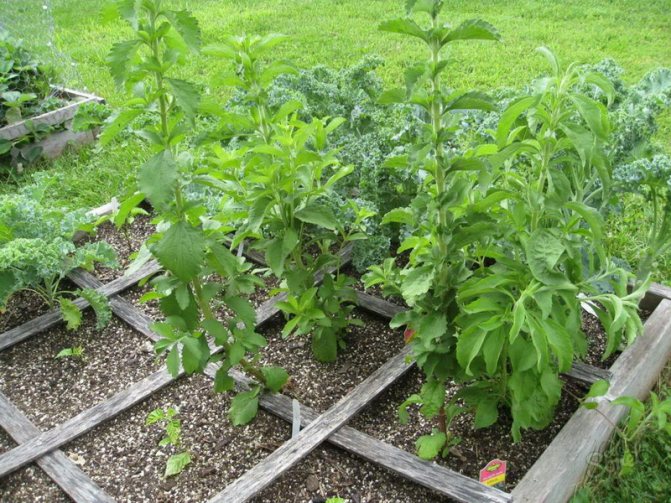

Stevia respects warmth and sunshine
Stevia respects compost and humus, but you should be careful with peat, as it grows poorly on it.
Legumes are good predecessors for her. The soil pH should be in the range of 5.5-6. If only clay soil is present in the garden, then sod, humus and coarse sand should be added to it so that it becomes loose and light - such as Stevia loves.
Stevia release form
On the basis of medicinal raw materials, many forms of drugs are produced:
- powder (in packages or sachets);
- extract in liquid form;
- dry leaves.
The additional processing to which the raw material is subjected, deprives it of calories and bitterness. At the same time, the taste remains 100 to 150 times sweeter than regular sugar. Baking, preserves, compotes and other drinks using this sweetener are recommended for diabetics and overweight people.
How to use stevia instead of sugar?
It should be clearly understood that the sweetness of the stevia sweetener is an order of magnitude higher than the usual sugar. As a result, it is necessary to represent the volumes that are recommended to be added to food and drinks, so as not to exceed the dosage and not to lose the flavor characteristics. And the excessive consumption of the product does not make sense.
As you know, you can buy stevia in the following forms:
- Ground leaves.
- Stevioside.
- Stevia extract.
The optimal ratio of standard sugar with different types of stevia processing is presented in the following table.
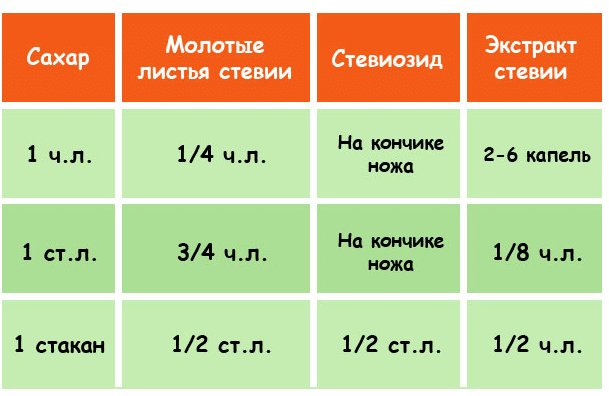

Save this information so that you always have it at your fingertips. This advice is especially relevant for those who are just starting to take a natural sugar substitute, stevia (honey herb).
Preserving the stevia rhizome
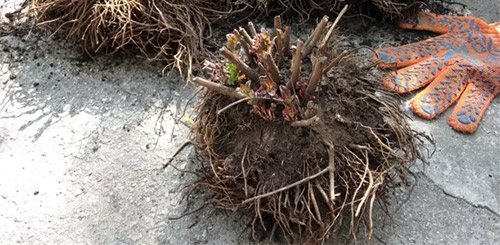

The second option for wintering stevia is digging and storing rhizomes. The fact is that in the first season after planting, stevia grows slowly and does not have time to fully reveal its potential. She is, after all, a perennial. And to get the most out of her, she needs to be able to grow in the next season. For this, stevia rhizomes are dug up for the winter and stored until spring.
After harvesting, the roots are removed along with a lump of earth and placed in a prepared box or box. The bottom of the box should be covered with a layer of soil (3-5 centimeters). The roots are covered with moist soil, leaving only cuttings on the surface. You need to store the rhizome in a dark room at a temperature not higher than 8 ° C and not lower than 4 ° C.Warmer conditions will provoke premature shoot growth, while colder conditions can cause the buds to freeze. It is also desirable to maintain the humidity at the level of 80-85%. If there is no cellar, it is worth trying to keep the rhizome on the bottom shelf of the refrigerator or on the insulated balcony.
In the spring, the roots are planted again in the ground and, if they managed to save them, the stevia bushes will grow faster and look more powerful than their relatives grown by seedlings.
What a smell and taste
Raw, untreated stevia is often bitter and has an unpleasant odor. After processing, bleaching or bleaching, it takes on a soft, licorice aftertaste.
Many of those who have tried stevia sweetener cannot but agree that it has a bitter aftertaste. Some even believe that the bitterness increases when stevia is added to hot drinks. It's a little difficult to get used to, but you can.
Depending on the manufacturer and form of stevia, this flavor may be less pronounced or absent altogether.
About diseases and pests of stevia
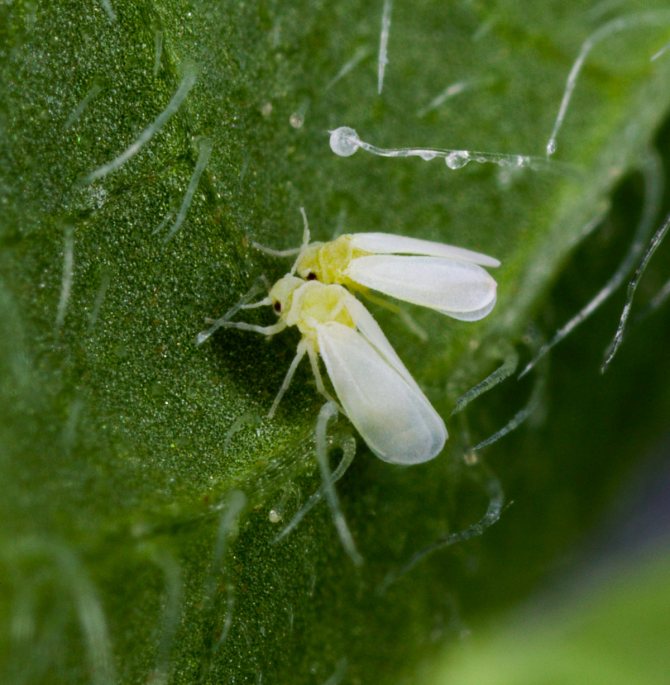

Greenhouse whitefly
In middle latitudes, the plant does not get sick and is practically not affected by pests. The problem can arise at the stage of growing seedlings. At low air temperatures and high humidity, the black leg can harm the seedlings, damaging the stem at the point of contact with the ground. Prevention of this disease is the disinfection of the soil with boiling water or a weak solution of potassium permanganate.
Indoors, stevia pots can be attacked by the greenhouse whitefly. Pests - butterfly larvae - settle in the lower part of the leaves and suck the juices out of them. To combat the whitefly and its larvae, a soap solution is used.
Harvesting and processing
The greatest mass of leaves and the maximum content of stevioside in them is observed in stevia at the beginning of flowering, when they are harvesting. Harvesting is very easy. You need to cut the stem of the plant at a height of 5-6 cm on the ground. A little more about this amazing plant:
Stevia (Stevia rebaudiana - honey herb) is a herb of the chrysanthemum family that grows wild as a small shrub in parts of Paraguay and Brazil. The glycosides in its leaves, including up to 10% stevioside, are responsible for the incredible sweetness, making it unique among nearly 300 species of stevia plants. There are indications that stevia (or "ka-he-he") has been used by American Indians to sweeten a natural drink called mate since pre-Columbian times. This small shrub grows on sandy soil high above sea level and can grow up to 80 cm in full maturity. Stevia is a rather unpretentious plant, it easily adapts to various soils. But, like other tropical plants, stevia cannot develop at temperatures below 6-8 ° C, while its roots cannot withstand temperatures below 0 ° C. The plant can be grown both outdoors and in a pot.
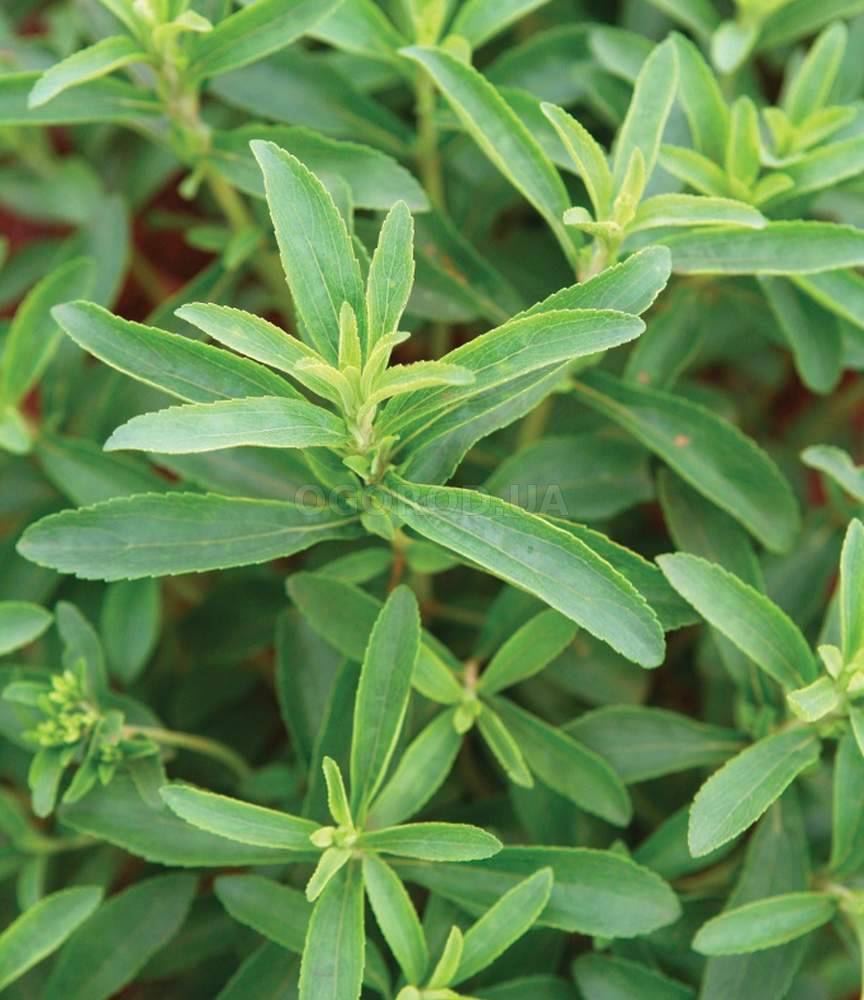

Sweet stevia secret
consists of a complex molecule called stevioside, which is a glycoside composed of sucrose, steviol and very small amounts of glucose. It is this complex molecule and a number of other related substances that are responsible for the extraordinary sweetness of stevia. Stevia herb in its natural form is about 10-15 times sweeter than regular sugar. Stevia extracts in the form of steviosides can exceed regular sugar in sweetness in terms of sweetness in the range from 100 to 300 times.
Cultivated plant stevia
has been cultivated in Paraguay and surrounding countries for over 1,500 years. Although native Guarani Indians seem to have been using the leaves of this herb as a sweetener since pre-Columbian times, a Paraguayan natural scientist named Antonio Bertoni first "discovered" it in 1889.
Initially, Bertoni designated this plant as Eupatorium Rebaudianum Bertoni (related to the steep), but later referred it to the genus Stevia (1905).It is estimated that there are over 80 stevia species known to grow wild in North America, and possibly two hundred additional species native to South America. Of these, only Stevia Rebaudiana and two other now extinct species have what turned out to be the natural sweetness that is their hallmark. Around 1901, the British consul in Asuncion, K. Gozling, wrote: “This plant, which the Indians have known for many years, and whose secret, was strictly kept by them, grows in the highlands of Amambai and near the source of the Mandi River. Its leaves are small, and the flower is even smaller, and the Indians call it "ka-he-he", which means "sweet grass", because of its sweetness, and only a few leaves are enough to sweeten a large cup of tea, which also give pleasant aroma".
Two French chemists named Bried and Lavelle began solving the stevia mystery in 1931 with research work with leaf extract Stevia rebaudiana
... Their research resulted in a pure white crystalline substance, which they named "stevioside", which was obtained in 6% yield. They found that this substance is 300 times sweeter than sugar and does not cause any obvious toxic effects in various experimental animals.
In 1941, due to a shortage of sugar and other sweeteners in England, due to the blockade of German submarines, a replacement sweetener was sought that could be grown in the British Isles. The director of the Royal Botanic Gardens, Kew commissioned R. Melville to investigate stevia as one of the likely possibilities. Melville's report shows that he believed Stevia Rebaudiana might be the substitute they are looking for. The work of Bridel and Lavelle was continued in 1952 by a research team at the National Institute of Arthritis and Metabolic Diseases, an affiliate of the US Public Health Service, in Betasta, Maryland. Both of them increased the stevioside yield up to 7%, based on the improved extraction procedure, and revealed the main features of the large and complex stevioside molecule. Their research also confirmed that stevioside is the sweetest natural food found, nitrogen free and almost glucose free.
In 1954, the Japanese began to seriously study stevia and grow it in greenhouses in Japan. And in 1971, the Chinese scientist Dr. Tei-Fu-Chen visited Paraguay, where he became so interested in stevia that he applied for a residence permit in both Paraguay and Brazil. The non-chemical extraction method recorded in the herbal manuscripts of the Chinese Emperors became the method of extracting the stevia product, and it removed both the unwanted color and the bitter taste from the stevia leaves. Soon after Chen began his research on stevia, the Japanese food industry began to use it extensively to sweeten marinades, dried foods, dried seafood, fish and meat products, soy sauce, fruit juices, soft drinks, frozen desserts, chewing gum, and low-calorie foods.
The penetration of Stevia into the industrialized countries' market began with Japan. Already in 1985, it produced more than ten types of food products using processed products stevia plants
... Consumption of products based on it is more than 10 thousand tons per year. For 10 years in Japan, more than 240 patents, technologies and developments have been developed and introduced into production. One of the types of processing of the Stevia plant, stevioside, is a strategic raw material.
The biggest user remains Japan, which began growing stevia plants in greenhouses in 1954 as part of a nationwide rescue program following US nuclear bombings. Using stevia
also increased due to Japanese consumers' health concerns about sugar, which has been associated with tooth decay, obesity and diabetes. By 1987, a total of 1,700 metric tons of stevia leaves had been harvested, yielding an estimated 190 tons of stevioside extracts. By 1988, stevia extracts had captured 41% of the high-potential Japanese sweetener market.
The Japanese food industry uses stevia in a wide variety. Its main use, surprisingly, is in salty foods, where stevioside is used to suppress the pungency of sodium chloride. This combination is common in Japanese food in foods such as pickled vegetables, dried seafood, soy sauce, and miso foods. It is also used in drinks, including the Japanese version of Diet Coca-Cola. Stevia
has also been used in candy and gum, baked foods and cereals, yogurt and ice cream, ciders and teas, and toothpastes and mouthwashes. Of course, a significant portion of Japanese stevia is consumed directly as a table sweetener.
The Japanese also set the tone for the purification of stevia extracts into other sweet-tasting glycosides besides stevioside
... These include: rebaudiosides A, B, C, D, and E; dulcoside and steviolbioside. Rebaudiosides A and E are especially notable because they have a more refined sweet taste than stevioside, with less of the characteristic bitter aftertaste. Many "recipes" for the extraction of glycosides have been patented in Japan.
stevia
as well as combinations of stevia sweeteners. One common combination of sweeteners is stevioside with licorice extract, glycyrrhizin, which results in improved flavor quality for both sweeteners.
Food technologists in Japan have also discovered a lot of important information regarding the application. stevia
when processing products. First of all, stevioside and others
stevia extracts
relatively heat-resistant compared to other natural and synthetic super sweeteners. One study in 1977 showed very low levels of degradation under a variety of acidity (pH) conditions when stevioside was heated to 100 ° C for twenty-four hours. It has also been shown that stevia extracts do not ferment and do not contribute to the browning reaction of cooked or baked foods like many other natural sweeteners. Another advantage
stevia
is that it does not form precipitates in acidic solution, making it a sweetener compatible with carbonated soft drinks. Finally, many formulations and mixtures of extracts have been developed
stevia
to highlight specific flavor profiles, such as a product designed for frozen desserts requiring a light yet sustained sweetness. In this and many other industrial applications, extracts
stevia
and stevioside have been shown to be versatile sweeteners.
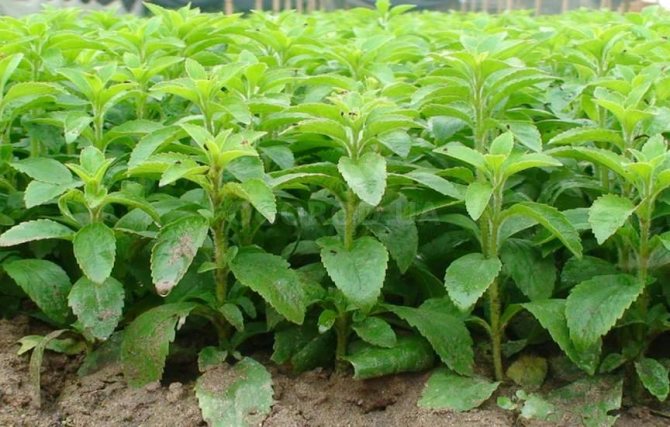

Stevioside has also been approved as a dietary supplement in South Korea and is widely available in China, Taiwan, and Malaysia. In China from the leaves stevia
make teas that are recommended "for increased appetite, better digestion, for weight loss, to preserve youth and as a sweet low-calorie tea." In the United States, the widespread use of processed products from the Stevia plant began in 1995, and already in 1997, on their basis, the Pentagon completely replaced the entire diet of its army. Since 1986
stevia
grown in Ukraine and Crimea. In 1987, the cultivation techniques and planting material of Stevia were transferred to Uzbekistan, and in 1991 to Russia.
In this regard, Dr. Daniel Morey says: “The longest experiments and safety tests were carried out in Japan during product analysis. stevia
as a possible sugar substitute.Results for toxicity of processed products
stevia
always had a negative result. At the same time, there were no deviations in the characteristics of chromosomes, cancer, birth defects, acute or chronic neoplasms, as well as no negative phenomena in changes in weight and food consumption. "
The IX World Symposium on Diabetes Mellitus and Longevity, held in China in 1990, confirmed that Stevia is one of the most valuable plants that help increase the level of bioenergetic capabilities of a person, allowing them to lead an active lifestyle until old age, for which it was awarded a gold prize.
As a result of the Research Institute of Food Hygiene, RNGC M.3. Ukraine, since 1986, for five years, medico-biological, hygienic, biochemical, morphological and physicochemical studies on a living organism, it was proved that the products of processing plants stevia
, with prolonged use, it is absolutely harmless. There were no negative effects. Weight loss in 31 days was 5-7 kg. In animals with a model of diabetes mellitus and obesity, a beneficial effect on the state of carbohydrate and lipid metabolism was observed.
According to the conclusion of the ESC RAMS of the Ministry of Health of the Russian Federation, diterpene Stevia glycosides
possess antihypertensive, reparative, immunomodulatory and bactericidal properties, ensuring the normalization of the functions of the immune system and increasing the level of bioenergetic capabilities of the body.
The sweetness of Stevia leaves
is determined by the presence in them of a complex of sweet diterpene glycosides, which are organic compounds of a non-carbohydrate nature. Equivalent to the sweetness of the sum of diterpene glycosides contained in
stevia leaves
and received the general name "stevioside", the average is 300 units.
The main advantages of diterpene glycosides are: sweet taste without foreign taste, practically zero energy value, resistance to heating, storage and freezing, as well as to the effects of acids and alkalis, easy solubility, small dosage, harmlessness with prolonged use, inclusion in the metabolic process without involvement of insulin.
Stevia components have the properties of replacing sugar in the diet of people with metabolic disorders, including those with diabetes mellitus, atherosclerosis, obesity and other concomitant diseases. Stevia is an excellent and healthy natural sugar substitute. One gram of stevia leaves is equivalent to 25 g of sugar, i.e. stevia leaf is 25 times sweeter than sugar. With a daily consumption of 4.0 g of a leaf, which is equivalent to 100 g of sugar, their energy value is 3.97 kcal. In recent years, numerous studies in a number of developed countries have shown that with regular eating stevia
the content of glucose in the blood decreases, blood vessels are strengthened, the growth of neoplasms is inhibited (at home - in Paraguay for centuries it has been used to sweeten tea and other food products, the percentage of insulin-dependent people in this country is several times lower than in other countries).
Stevia
positively affects the activity of the liver and pancreas, prevents the formation of ulcers of the gastrointestinal tract, eliminates allergic diathesis in children, improves sleep, increases physical and mental performance.
Numerous studies have shown that regular consumption of stevia reduces the content of sugar, radionucleides and cholesterol in the body, improves cell regeneration and blood coagulation, inhibits the growth of neoplasms, strengthens blood vessels, and choleretic, anti-inflammatory and diuretic effects are also noted. Stevioside prevents the formation of ulcers in the gastrointestinal tract (GIT).Acetyl salicylic acid, butadione and other anti-inflammatory drugs taken together with stevia do not have a damaging effect on the walls of the gastrointestinal tract.
It has been established that complete safety is guaranteed with daily consumption of dry stevia leaves in an amount of 0.5 g per 1 kg of body weight.
Other properties of stevia:
- Essential oil stevia
contains more than 53 different substances and components. It has an anti-inflammatory and healing effect, therefore it is effective for various skin irritations, cuts, burns, frostbite, eczema. If the wound is moistened with a solution of stevia, then it heals without scarring. Healing of trophic ulcers is also accelerated. The infusion is used to treat purulent wounds and postoperative sutures. - Stevia contains tannins that bind the proteins of the mucous membranes and skin, turning them into stronger insoluble compounds, depriving food of bacteria that enter the damaged area. Therefore, the plant has a pronounced anti-inflammatory and protective effect.
- Stevia
reduces pain from burns and bites from poisonous insects. - The concentrated stevia infusion is extremely useful for the regular care of various skin types. Regular use in the form of masks makes the skin soft and elastic, smoothes wrinkles. The preparations based on this plant are effective for the care of the skin around the eyes.
- Stevia
helps to fight various skin diseases, including dermatitis and eczema. - Stevia leaf contains silicic acid, which improves the condition of connective tissue, skin, hair and nails. Stevia decoction is successfully used, for example, for the treatment of seborrhea.
- The substances in this plant inhibit the growth and reproduction of a number of bacteria and other infectious organisms, including bacteria that cause diseases of the teeth and gums. Stevia
protects tooth enamel from destruction, it is used in toothpastes, rinses, chewing gums for caries and paradanthosis. - The combination of colloidal silver and stevia decoction allows you to multiply the effect of the finished product, both in the direction of antibacterial and anti-inflammatory effects, and in the direction of nutrition, softening, regeneration and slowing down the aging process of the skin.
Growing Stevia: Personal Experience
Diabetes patients use it as a sugar substitute.
Almost everyone knows this. But the “healing range” of stevia is much wider. Our local herbalist told me about the beneficial properties of the plant. It turns out that dried leaves and stems are effective in the treatment of ulcers with their help to normalize blood pressure.
Stevia leaves contain essential oils that help relieve inflammation and heal wounds.
They say using the plant correctly can even reduce your cravings for tobacco and alcohol!
Stevia came to me with a small cut. I have rooted it and have been watching the plant for 2 years, I try to propagate it in winter.
In the open field, the bush grows rather quickly, the soil is needed with a high nitrogen content. And since I use stevia for medicinal purposes, I do not add mineral fertilizers to the soil. I use only organic. At the end of May, I plant the bushes in open ground at a distance of 20 cm from each other. For two weeks the plants adapt, then (with regular watering) they grow.
In freedom, they grow much more vigorously than in the house, and the leaves in the open sun store more sugars. When buds begin to appear, I cut off the ground part and lay it out in a dark, well-ventilated place to dry.
After pruning, I feed the plants with infused organic matter (weeded grass and manure), which I dilute 1:10.
Wintering setvia
With the onset of cold weather, I dig out the bushes, plant them in containers and put them in a cool, bright place.
Sometimes, as the earthen clod dries, I water it.
Saving stevia is not easy: some specimens sometimes die right away. At this time, the growth of stevia slows down, a period of rest begins.
Stevia cuttings
Young shoots appear in the spring. I cut them off, leaving two lower buds on the stem. I put the cut parts in water for 1 hour, then plant them in light sandy soil and cover with polyethylene.
Nadezhda TERYAEVA. Zhlobin, Gomel region
Specialist comment
Since stevia is not officially recognized as a medicinal plant and has not yet been included in the State Pharmacopoeia of the Russian Federation, I would recommend using it very carefully. And not to use by patients with hypertension, pregnant women and children.
On the treatment of alcohol and tobacco addiction, I have not come across information anywhere. Considering that stevia has a blood-purifying and antitoxic effect, it is logical to assume that it can help relieve hangover and improve well-being.
STEVIA: SWEET HOTEL
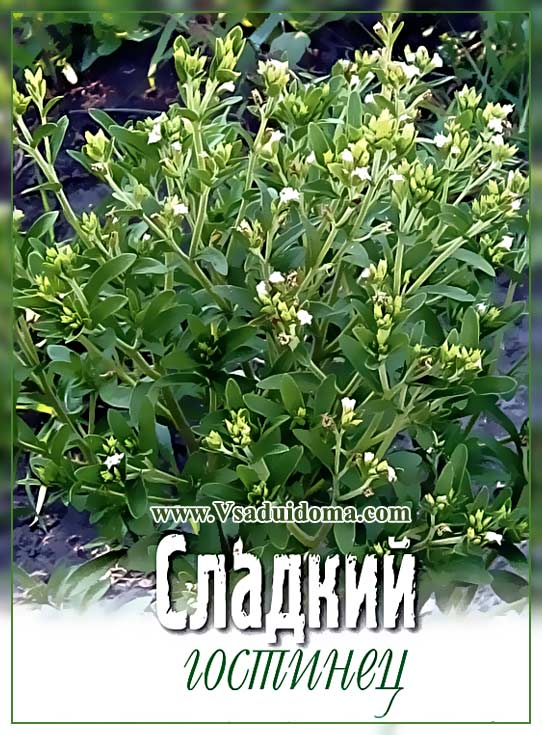

Stevia photo
Stevia (sweet herb) has been talked about and written about a lot lately. Interest in her has increased dramatically after in 1990, at a world symposium in China, stevia was recognized as one of the most valuable plants that can improve health and prolong life. This herb is also known in Ukraine. Despite the exceptional thermophilicity of stevia, some gardeners, including me, still managed to breed it on their plots.
Honey potion
Perhaps no plant in the world has experienced such vicissitudes of fate as stevia. Tear and chew for health - this is how it was perceived for a long time in Paraguay, in the homeland of this plant. Locals did just that, while maintaining one of the lowest diabetes incidence rates in the world. The first reports of a sweet herb used by Indians to sweeten food date back to 1887. It was in this year that the South American naturalist Antonio Bertoni discovered stevia. He described, studied, classified the plant as a botanist and gave it the name Stevia Rebaudiana, after Ovid Rebaudi, the scientist who pioneered the chemical analysis of sweet stevia juice. Then it was opened again, then forgotten ...
After the atomic bombings of Hiroshima and Nagasaki, the Japanese added a new page to Stevia's track record. In a hurry, they began to look for an adaptogen (a drug that increases the body's resistance to harmful effects) of plant origin. The choice fell on a South American plant, which they began to actively use for the health of the nation.
On the market of the Land of the Rising Sun, this plant began to occupy more than 80% of the world harvest and 90% of the consumption of dry leaves. Huge funds were directed to the cultivation and purchase of its raw materials in other countries. Until recently, stevia was known only to specialists. But after the Chernobyl tragedy, the popularity of the plant has sharply increased, the demand for medicinal raw materials from stevia has increased tenfold. Scientists, doctors started talking about her, articles appeared in newspapers and magazines.
Dry stevia leaves are 30 times, and the sweetening ingredient (stevioside) is 300 times sweeter than sugar. But not only this brought the plant worldwide fame. The main advantage of stevia is that it provides energy to a person without the help of insulin, which is especially important for diabetics and for those who have high blood sugar levels.
In addition, the plant helps to strengthen blood vessels, inhibits the growth of neoplasms, helps with diseases of the gastrointestinal tract, accelerates the utilization of bad cholesterol and radionuclides from the body. With the constant use of the extract from dry leaves, the body is rejuvenated, the skin on the face becomes smooth and elastic, wrinkles are smoothed. It is not difficult to prepare such a hood at home. For this, 1.5-2 tbsp. tablespoons of dry stevia leaf are poured with 1 glass of water, boiled for 6-8 minutes, and then infused for 45 minutes.
This extract is added to tea and to all dishes that traditionally use sugar.
Growing stevia is not easy. She cannot stand the winter and dies.
This plant only tolerates slight frosts. You can propagate sweet grass by cuttings, layering, dividing the bush, seeds. Having tried all the ways, I opted for the propagation of stevia seeds. However, there are some nuances here too. Considering that the stevia seeds are very small, and their germination rate is low, even minor deviations from agricultural technology dramatically reduce the seedling yield. I, for example, do this. I ideally level the moistened soil mixture, consisting of sod land and humus in equal parts and 20-25% of sand. I compact and water. Peat cannot be used, as the bacteria in it will lead to the death of seedlings. I soak the seeds for 30 minutes in warm water with the addition of potassium permanganate (0.5 g per 1 L of water), then dry them and sow them evenly on a moistened soil surface.
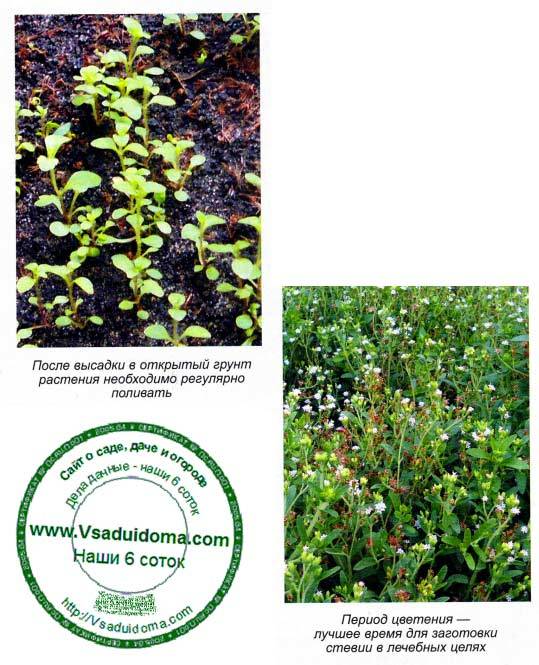

Stevia photo and care
For better contact with the soil, I press the seeds with my palm and lightly sprinkle them with soil on top, or rather, powder them. If the seeds are completely covered with soil, they will not sprout. I water the crops, not allowing the seeds to wash off, and cover with a film. The soil under the film must always be moist. During this period, it is important to protect crops from direct sunlight, for example, shade with newspapers. I put the seedling boxes in the warmest place for this time. After 6-8 days, shoots of stevia and weeds appear. It is very easy to distinguish them: the weeds are stretched out, there is no stevia. It is best to sow seeds on February 20-25.
After the emergence of seedlings, I transfer the seedling box to the brightest and warmest place. Seedlings grow very slowly. During this period, it is important to spray the seedlings regularly (at least 6-8 times a day) and monitor the temperature and humidity. The plant should be under the film throughout the entire seedling period. When two or more real leaves appear, I transplant the seedlings together with a clod of earth into separate pots. Seedling care is usual - watering, feeding.
I plant stevia in open ground in the third decade of May, when the threat of frost has passed. If there is film or agrofibre, the plants can be planted two weeks earlier. In each hole I bring 0.3-0.5 kg of vermicompost or humus and 2 tbsp. tablespoons of ash. Planting scheme: distance in a row between plants 35-40 cm, row spacing 60 cm.
I was convinced that the plants grow and develop better in the open field, if they are covered with foil or agrofibre for at least 2-3 weeks. Under the shelter, you can carry out foliar feeding of plants with chicken droppings. To do this, fill 2/3 of a bucket of fresh chicken manure with water above the level of the droppings. The droppings will begin to decompose, and the carbon dioxide will dramatically accelerate the growth and development of the stevia.
After planting, the plants need to be watered regularly, especially in dry years. When the stevia blooms, it is a signal that it is time to harvest the healing leaves. During this period, the greatest amount of stevioside accumulates in the leaves. Plants cut at a height of 10-15 cm from the ground are dried in the shade. I harvest stevia for seeds at the end of August - September, when the pedicels of the plants turn black. You need to carefully monitor the maturation of the seeds, if they are not removed in time, they will scatter.
Growing stevia in the garden is a chance to solve your health problems without resorting to medications. Thanks to this plant, which has unique healing properties, many ailments have been forgotten in our family. I advise you to make friends with stevia too.
Great stevia recipe
KULICH WITH STEVIA
Sour milk - 300 g, flour - 220 g, cottage cheese - 100 g, vanilla sugar - 8 g, baking powder - 4 tsp, lemon peel - 2 tsp, stevia extract - to taste, raisins - 100 g.
Stir the curdled milk with baking powder and leave for 10 minutes. Rinse the raisins, dry and mix with 1 teaspoon of flour. Grate the zest of one lemon.Combine curd, vanilla sugar, lemon zest and stevia. Pour in the yogurt and beat with a mixer. Add sifted flour and raisins, mix. Fill the cake mold 2/3 full with dough. Bake in the oven for about 1 hour.
The myth about the dangers of stevia
There is often a 1985 study on the Internet claiming that steviosides and rebaudiosides (found in stevia) allegedly cause mutations and, as a result, are carcinogenic. However, there have been many detailed and comprehensive studies that do not support this statement. In particular, in 2006, the World Health Organization (WHO) conducted a comprehensive assessment of experimental studies conducted on animals and humans, and made the following conclusion: "steviosides and rebaudiosides are non-genotoxic, the genotoxicity of steviol and some of its oxidative derivatives has not been found in vivo" ... The report also found no evidence of carcinogenicity of the product. The report also says beneficial properties: "Stevioside has demonstrated a certain pharmacological effect in patients with hypertension and in those with type 2 diabetes."
Indications for use
Certified doctors do not deny the positive effect of funds based on a unique plant on the work of internal organs and systems.
This allows them to be used in the diagnosis of the following diseases:
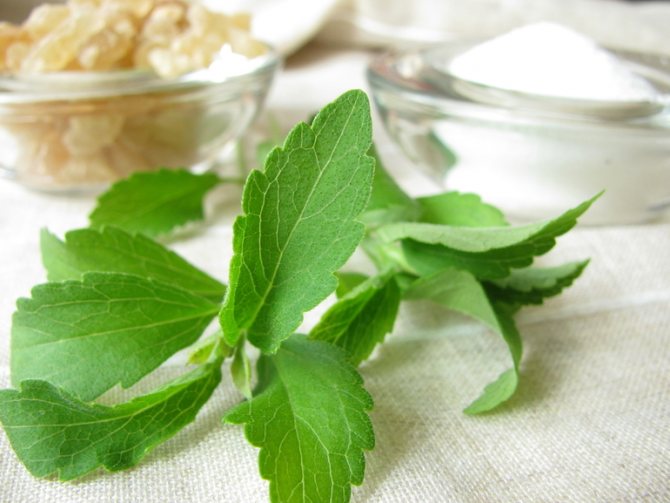

- pathologies of the cardiovascular system: atrial fibrillation, tachycardia, angina pectoris, ischemic heart disease in remission, initial and severe hypertension, atherosclerotic changes affecting the coronary vessels;
- endocrine disorders: thyroid disease, diabetes mellitus, metabolic disorders, provoking an increase in body weight, up to obesity;
- infection of the gastrointestinal tract with parasites, indigestion, decreased absorption of nutrients in the small intestine;
- colitis and enteritis of a chronic form with regular relapses;
- violation of the intestinal microflora after prolonged use of antibacterial agents or undergoing a course of chemotherapy;
- frequent constipation or loose stools that cause dehydration;
- the development of dermatitis or eczema, a chronic course of dermatological diseases;
- weakening of immunity, frequent respiratory diseases;
- vitamin deficiency caused by an unbalanced diet.
Stevia can be used by patients who experience strong emotional and physical stress, get tired at work. The herb, when used regularly, makes a person strong and energetic.
For patients with insomnia, the plant will also be useful, as it helps to normalize the psycho-emotional state. Studies have shown that stevia can reduce the risk of pancreatic cancer by 23%. This allows its use in patients with chronic pancreatitis to prevent the progression of the pathological condition.
Stevia is a natural sugar substitute
Gallery: stevia herb (25 photos)
Stevia benefits and harms, sugar substitute, photo
S. Esipov reported that he received 82 kg of white sugar from 250 kg of raw sugar produced from beets. This is how the first Russian crystalline sugar was obtained.
Localization of sugar in the plant. If sugars accumulate mainly in the cytoplasm of the cells of leaves and root crops, then polysaccharides (cellulose and pectins) - in the cell walls.
Pectin is one of the main polymers involved in the formation of the plant cell wall. When cells divide, a primary cell wall is formed, consisting only of cellulose. As the cell size increases during the development of plant seedlings, a secondary cell wall is formed and median plates are formed, consisting of cellulose and pectin.
Social buttons for Joomla
It is known that many metabolic diseases are provoked by the immoderate addiction of a modern person to sweets.
Doctors advise to reduce sugar intake to one hundred grams per day. Our ancestors, who did not know this refined product, knew how to sweeten their lives by eating sugar-containing plants.
And they were healthier.
In the old days, the Indians of North America cut the trunks of one of the maple varieties, collected the juice and evaporated the molasses from it. It would seem that the affairs of bygone days. But, having visited the northeastern United States, I was amazed that this method of obtaining a healthy sweet product was not only not forgotten, but even turned into an industry, and for many Americans, a family ritual.
When it comes time to harvest maple sap, it is always a holiday for Americans.
And they collect maple sap, like birch sap, in early spring. A metal corner with a hook is driven into a tree at a height of a meter from the ground, on which a bucket for juice is hung. It tastes almost the same as birch - slightly sweetish, refreshing.
Maple sap is evaporated over a fire in vats, periodically pouring from container into container.
When fresh juice is poured into the first vat, in the tenth it is already quite thick and dark. Twenty liters of maple sap makes about a liter of syrup - what one family can gather in a day's work.
The syrup is poured into jars, the hostesses proudly treat guests, sharing recipes for a variety of aromatic additives.
Americans, worried about their health and wary of sweets, use maple syrup with anything - pour over pancakes, add to tea and dough, to fruit salads.
Collecting juice is like a picnic. They leave not only with families, but often whole neighborhoods.
The work is fun and fast. One walks through the forest and changes buckets, another prepares firewood for the stove, the third is already starting to evaporate the first portions of syrup.
For Russia, where sugar maple does not grow, maple syrup is an exotic product. But now it is becoming available. Not so long ago, for example, imported oatmeal in sachets appeared in our stores, in which maple syrup was added instead of sugar.
Once upon a time, maple syrup was also harvested in Europe, but since the introduction of sugar beets containing up to 50% sugar, this occupation has been left to pragmatic Americans.
True, in France, in Germany, and even here, many people still like to try birch sap on vacation outside the city.
It's a lovely activity to arrange jars near birch cuts in a damp, spring-like fresh forest.
I remember that as a child, in the company of boys, we competed to see who would get the most pleasant-tasting drink. His eyes rippled with black and white birches. They seemed so similar to each other, and we argued who would quickly find the jar full of juice forgotten by the tree.
Only after growing up did they learn that birch sap is very rich in vitamins and useful natural sugar - its concentration in molasses reaches 60-70%.
Stevia, E960 - effect on the body, harm or benefit?
Stevioside is not degraded in the human body due to the lack of essential enzymes.
This is the reason for the zero calorie content of the E960 additive. Stevia has the following health benefits:
- helps to reduce body weight;
- improves the condition of the circulatory system;
- lowers systolic pressure in the arteries;
- improves the quality of life of diabetics.
All the beneficial physiological effects are, in fact, explained by the sweetish taste of stevia and its inability to be included in the metabolism.
Without fear of gaining weight, a person can consume soft drinks, products that include the E960 additive. It improves mood, physical condition, leads to the normalization of body weight and metabolism.
In the last century, the effect of stevioside on the body of mice was studied abroad. It turned out that this substance is harmful to pregnant individuals, since it negatively affected the fetus.
It was decided to ban this additive.Subsequently, its mutagenic properties were not confirmed. E960 additive is approved for use in post-Soviet countries, Europe, and many other regions.
Stevia (herb): medicinal properties, application
For rooting, you need to take a well-ripened stalk with 5-6 pairs of leaves and put it in water, or plant it at home in a seedling cup. At first, to reduce evaporation, it is advisable to cover the stalk with a plastic bag. At room temperature, rooting of the lipia cuttings usually takes two weeks. It can be planted in open ground only when high temperatures are established.
In areas with cold summers, it is preferable to grow lipia in greenhouses.
In the bright southern sun, in our hot climate, the plants are oppressed, the leaves of the lipia take on a bronze tint. Therefore, in our country, lipia develops best in partial shade under trees with a sparse crown (for example, in the shade of peach trees).
As I have seen, the content of the sweetener in the aerial part of the plant is highly dependent on the growing conditions and on the age of the lipia. The leaves from the central part of the shoots turned out to be the sweetest, grown at low temperatures (about 25 degrees), with a moderate amount of nitrogen fertilizers.
Older lipia leaves (more than two months old) begin to taste bitter.
For raw materials, cut off the shoots of lipia, which have not yet begun to lignify, and dry them in the shade, like any grass.
Subsequently, dried sweet Aztec herb can be added to tea or homemade preparations.
Sugar Plants contain in their stems, tubers or fruits sweet juice (sugar or glucose), starch or inulin used for the industrial extraction of sugar. The main plants for sugar production are:
- in the tropical region. sugarcane.
- in temperate latitudes, sugar beets.
You can also use as sugar plants:
- corn (sugar is obtained from grain starch), which gives up to 1 ton of sugar per hectare;
- sorghum (grain and stems containing up to 12% sugar);
- chicory, put forward due to high yields and growth in sowing.
r-nah as a valuable addition to beets, - Jerusalem artichoke (earthen pear);
- melons and gourds (watermelons, melons, pumpkin), giving the opportunity to develop the sugar industry in arid areas.
Nowadays, sugar is mainly obtained from sugar cane and sugar beet. Produced in the form of granulated sugar and refined sugar.
Sugar was once made only from sugar cane, which grows in India, China, Cuba and other countries where the climate is warm and humid enough for this plant. Therefore, sugar was a very expensive curiosity. In many countries, honey, sweet maple, birch, and linden sap was used instead.
In 1747 g.
German chemist Andreas Sigismund Marggraf spoke at the Prussian Academy of Sciences, where he reported that he had found sugar in white beets, similar to sugar in sugar cane. But due to the insufficient sugar content of beets, which did not exceed 1.5%, and the low level of development of the productive forces of that time, this discovery did not find practical application. After the death of Marggraf, his apprentice chemist Franz Karl Achard began to cultivate fodder white beets in 1784; and by 1799 he got the first sugar from it.
The first mention in historical documents of the appearance in Russia of crystalline sugar, imported with "overseas goods", appeared in 1273.
Due to its high price, sugar has been a luxury item for many years, and at one time it was sold in pharmacies for the equivalent of silver. The demand for it has greatly increased since the middle of the 18th century, when tea began to be consumed in Russia, which quickly became a national drink. In 1718, the merchant Pavel Vestov received permission from Tsar Peter I to build factories for processing imported raw cane sugar.
Vestov was instructed to produce sugar, the quality of which should not be inferior to foreign, and to sell at a price not higher than the market price.The first plant began operating in 1719 in St. Petersburg on the Vyborgskaya side.
In Russia, Yakov Stepanovich Esipov played an important role in the creation of technology and industrial production of beet sugar.
In 1799-1801. on his estate in the village of Nikolskoye, Podolsk district of Moscow province, he developed an original technology for producing sugar from beets with the purification of beet juice with lime.
At the beginning of 1802, J.
Where does it grow?
Stevia is native to Latin America. Stevia prefers light soils with low salinity, a semi-arid climate and plenty of sun. The natural habitat is the elevated plateaus and foothills of the South American continent. The largest number of wild-growing stevia is found in Paraguay. The same countries grow on plantations raw materials that are considered the best in quality (Fig. 2).
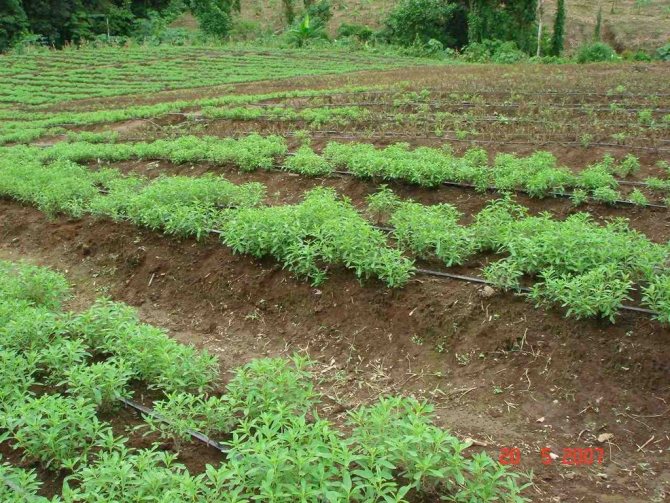

Fig. 2. Plantation of honey bush in Brazil
Stevia has taken root well in Southeast Asia. Since the 90s of the last century, it has been actively cultivated in many countries of this region. Today, China is the main supplier of stevia to the world market.
What do we offer?
In our electronic catalog you can buy a variety of plant-based products:
| Powder (stevioside) | Sachet | Pills |
| Liquid Stevia Glass Vials | Liquid stevia in plastic vials | Stevia syrup and other types of goods |
All our products are made according to the most advanced technologies in the field of extracts purification, therefore they do not have a bitter taste.
CALL BY PHONE +7
or
Stevia garden care
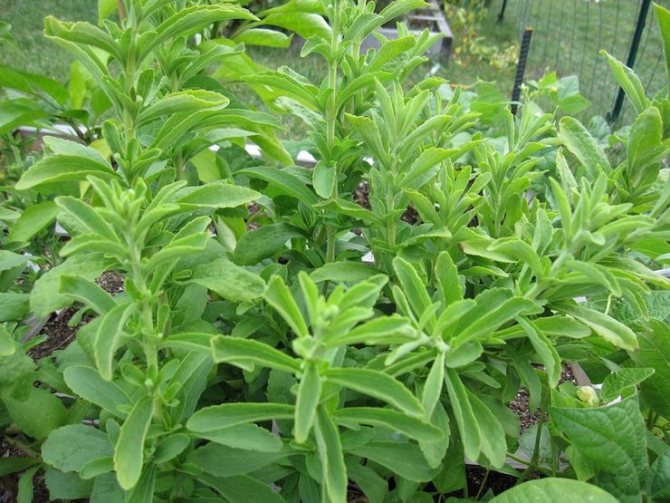

For the normal growth of stevia, frequent and abundant watering, gentle loosening of the soil and removal of weeds are needed. If this is not done, then the plant will not be able to grow and develop properly. Stevia loves always moist soil, but does not tolerate stagnant water. In order for the soil to be moist and not dry out quickly, after watering, it is necessary to mulch the soil around the plants well.
You need to feed a perennial plant every 2 weeks. Organic fertilizers such as mullein solution or bird droppings are suitable as top dressing. In autumn, you can feed the plant with compost or humus.
Can stevioside be used in children?
Pediatricians have no complaints about stevia, and nutritionists recommend including it in children's diets. In the children's menu, replacing refined sugar with honey grass gives a number of advantages:
- it is an excellent prevention of diabetes mellitus, the child's pancreas is freed from excessive sugar load;
- low calorie content helps keep weight normal;
- honey grass protects from such a sugar scourge as caries, it, on the contrary, strengthens the enamel of the teeth;
- stevia extracts for the body (unlike ordinary sugar) are not addictive, babies do not require more and more sweets;
- cases of allergy to stevia people are extremely rare.
Slimming stevia
People fighting overweight often use this plant in their diet. And this is understandable, because stevia is able to dull the feeling of hunger. This herb lowers appetite, preventing a person from overeating. The main way to use the product in its natural form is to add the leaves to a fruit or vegetable salad.
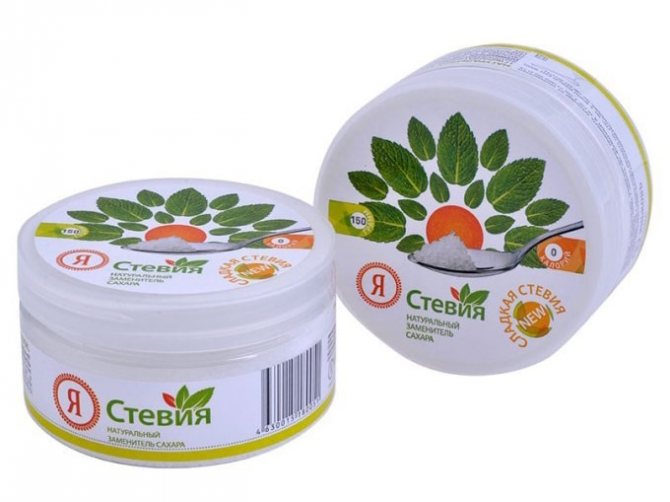

Regular use of stevia infusion allows you to remove toxins from the body, improve the metabolic process, which in combination has a beneficial effect on a person and contributes to the loss of excess weight. When using plant leaves, decoctions or herbal tea, do not forget about adherence to the diet. Only with this approach can we expect an effective result and loss of extra pounds.
Stevia, the benefits and harms of which are well studied, is considered one of the most effective and completely safe remedies in the fight against obesity. You should not expect a miraculous effect at a time of infusion or herbal tea.It is necessary to regularly use plants in the diet and only then the results will become obvious.
Taking stevia as a weight loss product helps cleanse the intestines, in particular, and the body in general. Cleansing the body is a long process. In this regard, “cardinal” decisions are fraught with serious health consequences. Honey grass gradually and extremely gently removes toxins, normalizes the intestinal microflora.

